Rachael Dickzen's Blog, page 9
April 9, 2020
I’m Playing a Lot More Piano These Days
Okay so I recorded this song (Ghosttown by Madonna, which seems REALLY on point with all the isolation and empty streets) like five times and something always went wrong. So here’s the final version, complete with cameos by Martok and John, me cracking up, and the end getting cut off by an alarm on my phone.
April 6, 2020
Diadems, Tiaras, and Crowns, Oh My!
So I’ve been hosting virtual lecture parties lately, since we’re all self-isolating and cooped up. At the most recent one, I presented on Diadems, Tiaras, and Crowns - talking about the different types and specific examples of each type. I had a lot of fun pulling together this slideshow and included as many pictures from around the world as I could.
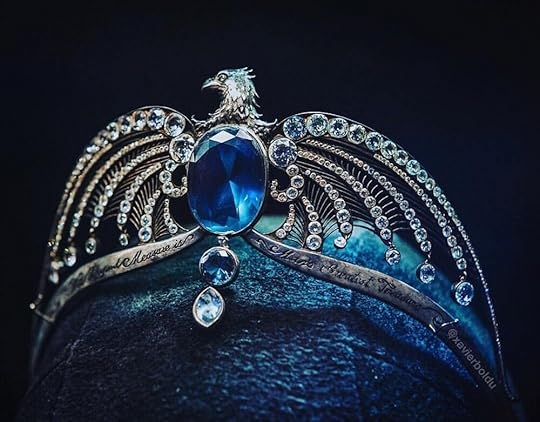
The Diadem of Ravenclaw from Harry Potter and the Deathly Hallows
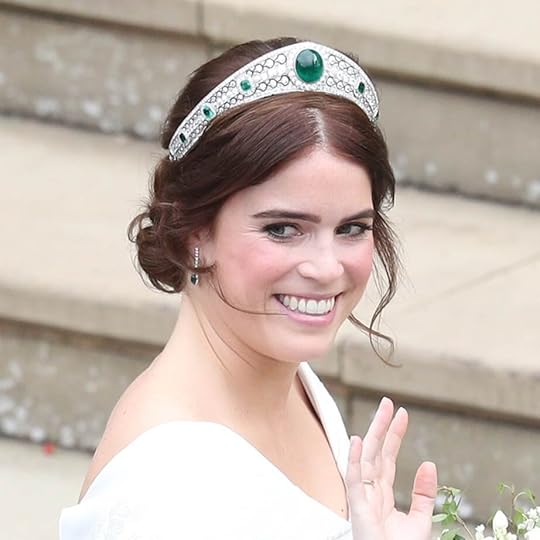
Princess Eugenie of the UK wearing the Greville Emerald Kokoshnik Tiara (1919)
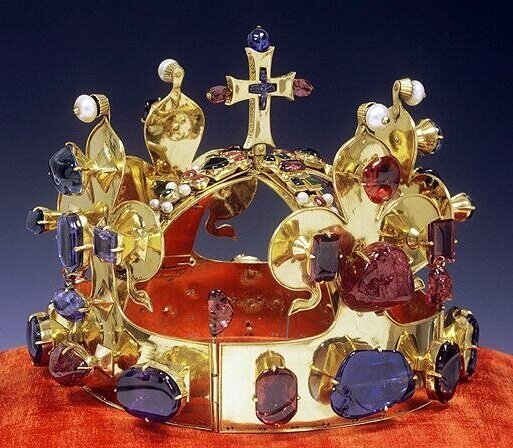
The Crown of Saint Wenceslas (Bohemia, 1347)
So I’ve been hosting virtual lecture parties lately, since we’re all self-isolating and cooped up. At the most recent one, I presented on Diadems, Tiaras, and Crowns - talking about the different types and specific examples of each type. I had a lot of fun pulling together this slideshow and included as many pictures from around the world as I could. My specific examples though, are all English/UK in origin, as that’s my passion and it’s frankly just a lot easier to find information on these than many of the other crowns and tiaras out there.
I will be putting all the information into blog post format at some point, but that’s going to take me a while because - lots of formatting and image upload! For today, I’m just loading up the slideshow so y’all can look through it at your leisure. Enjoy! If you have any questions, feel free to ask; I love talking about this sort of stuff!

Diadem of Princess
Sit-Hathor Yunet
(19th century BC, Egypt)
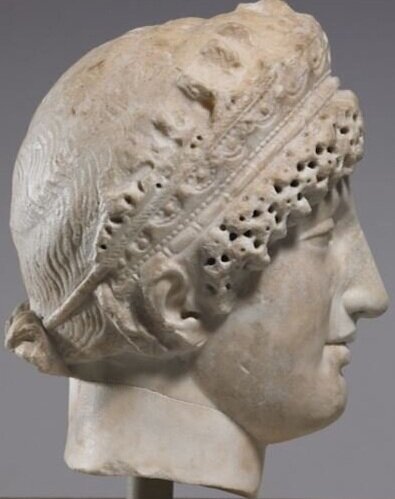
Greco-Roman bust (100 BC-100 AD)
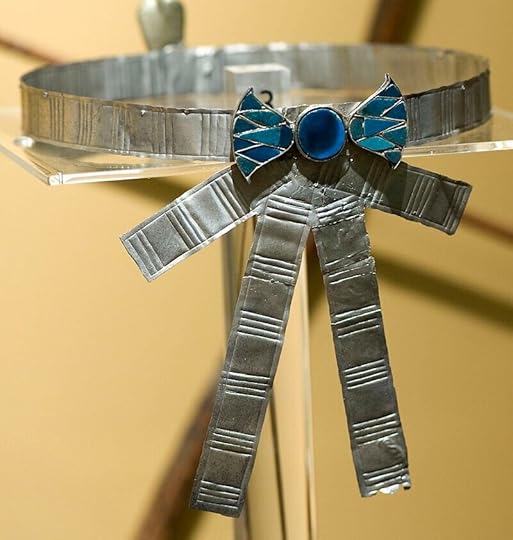
17th Dynasty diadem (1580-1550 BC, Egypt)
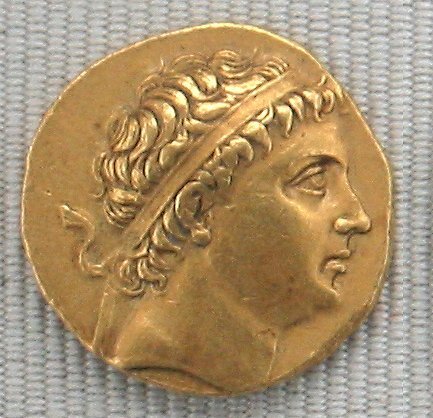
Diodotus of Bactria on a coin, (first century AD, around modern Afghanistan)
Diadems:
• Diadem – refers to any circular piece worn on the head to symbolize status and power.
• Name originates from the Greek diadein - “to bind around”
• Early diadems were just ribbons or laurel wreaths.
• Crowns, tiaras, coronets, and other royal headpieces all fall under the diadem umbrella.
• Very few crowns are known by this title today. I could only find one modern one.
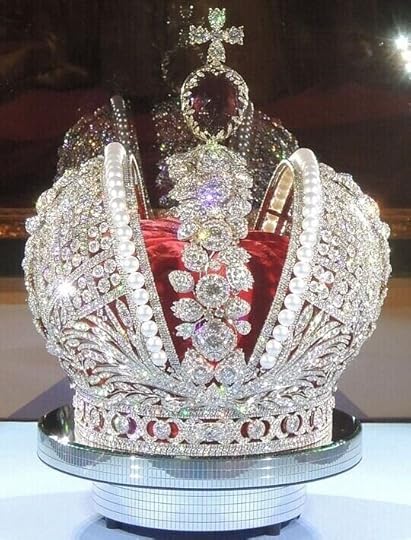
Replica, Imperial Crown of Russia (1762-1917)
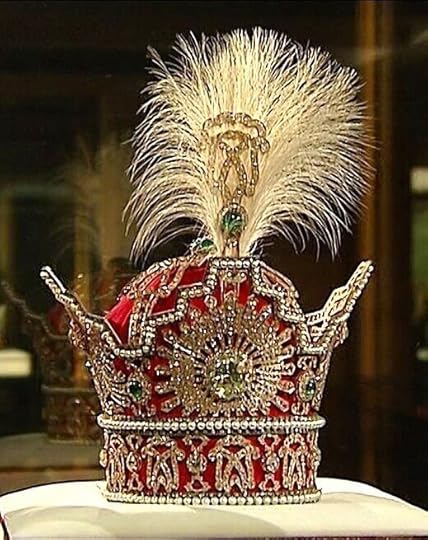
Pahlavi Crown (1926, Iran)
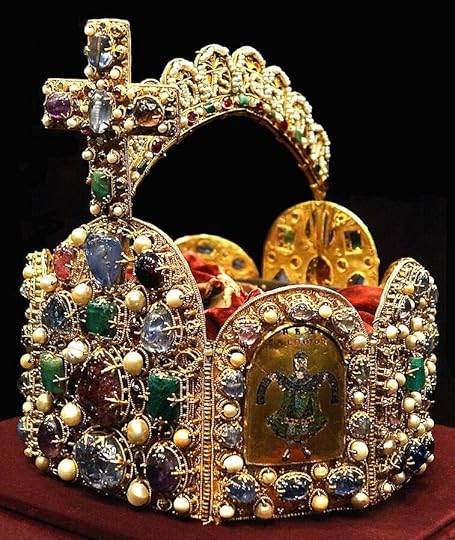
Holy Roman Empire (11th century – 1806)
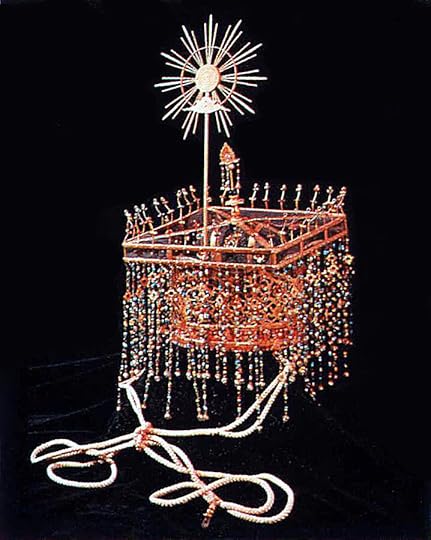
Crown of Japanese
Emperor Kōmei (1846-1867)
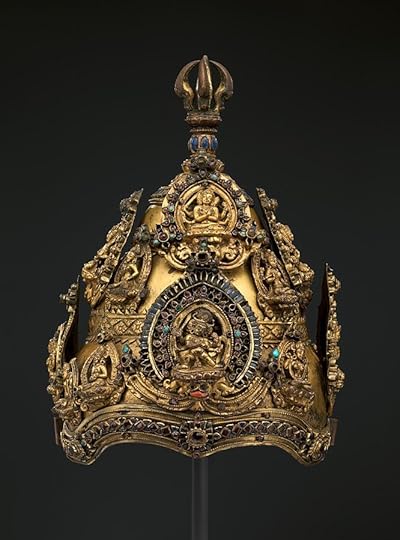
Crown from Kathmandu Valley (13th century, Nepal)
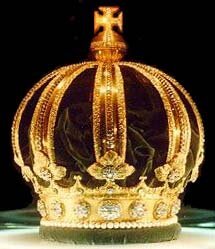
Imperial Crown of Brazil (1841)
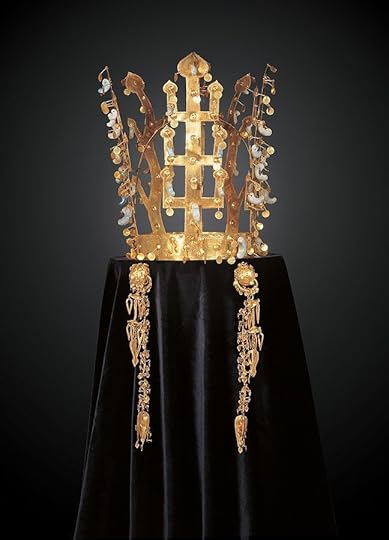
Silla (5th-7th centuries, modern day Korea)
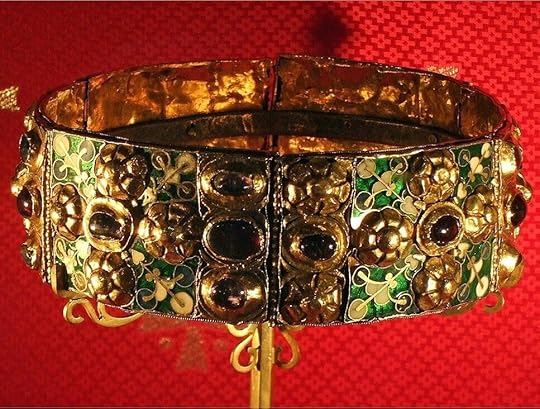
The Iron Crown of Lombardy (4th-5th century, modern day Italy)
Crowns:
• Crown – A full circle headpiece with an emblematic function associated with sovereignty and nobility.
• Open crowns, without bands overhead, are the oldest crowns, but closed crowns became the most popular ones in the middle ages and are the dominant type today.
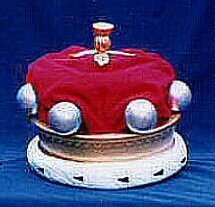
Baronial Coronet (modern, UK)
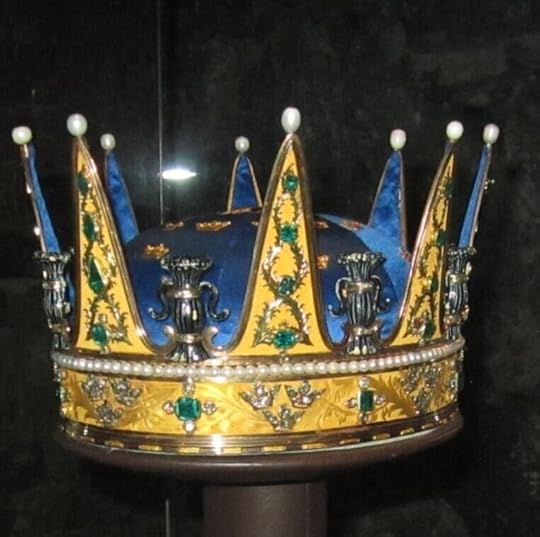
Ducal Coronet (modern, Sweden)
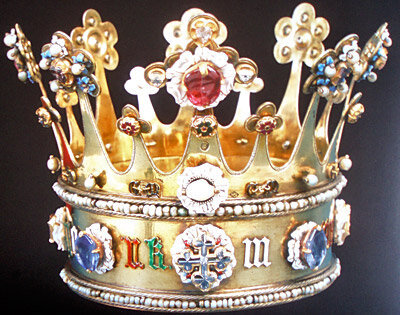
Margaret of York (sister of Edward IV and Richard III) (1454, England)
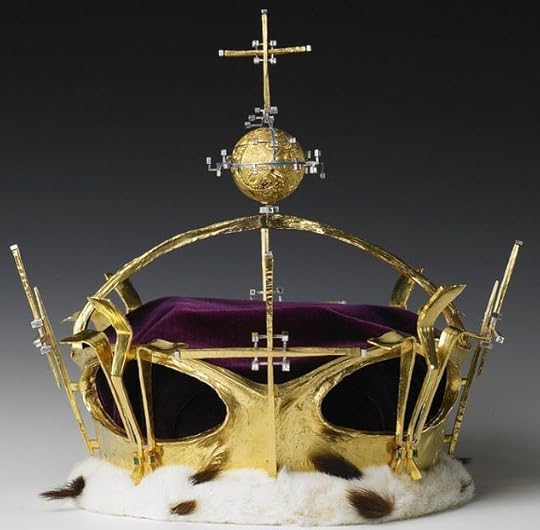
Charles, Prince of Wales (1969, UK)
Coronets:
Coronet – Small crown generally worn by dukes and earls at coronations, and often worn by princes/princesses at formal events.
• These are standardized for various peers, with different designs for each rank (e.g., Duke, Marquess, Earl, Viscount, Baron).
• Very often seen in heraldry on coats of arms and shields
• I really couldn’t find evidence of actual coronets outside of Europe, so it may just be a weird Europe only thing. It looks like they’re more often used in heraldry, like on coats of arms, then in real life – I struggled to find any pictures of them.
• Charles’s coronet for his investment in 1969 was controversially modern and abstract. A new one had to be made after his great-uncle, the former Edward VIII, took his into exile after he abdicated the throne. The designer used electroplating to make the crown, which hadn’t been used before, and was unsatisfied with how the orb kept coming out until a technician suggested electroplating a ping pong ball. It worked.
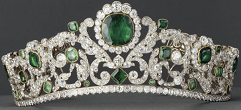
Duchess of Angoulême (1820, France)
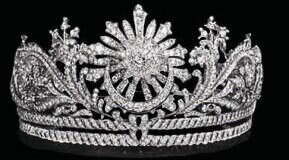
The Gandikj Diraja Tiara for the Raja Permaisuri Agong (1957, Malaysia)
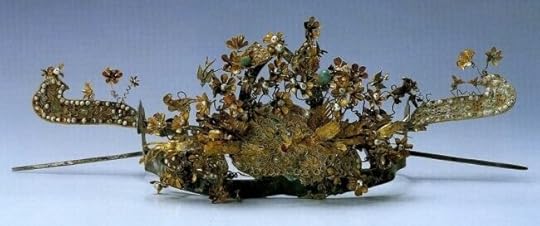
A Pearl and Emerald tiara (420–589, China)
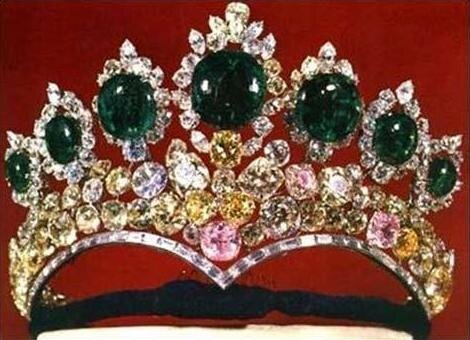
Empress Farah (1958, Iran)
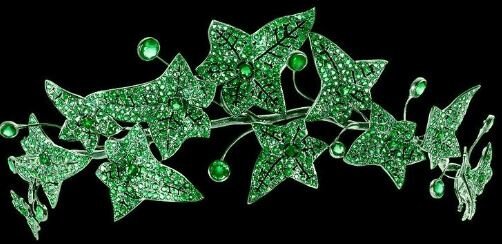
Queen Rania’s Boucheron Emerald Leaves Tiara (2003, Jordan)
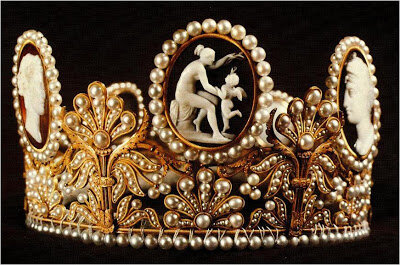
Cameo Tiara of Empress Josephine (1804, France)
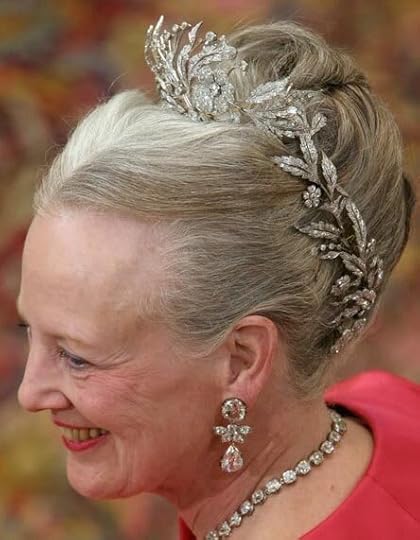
Queen Margrethe II’s Aigrette (~19th century, Denmark)
Tiaras:
• Tiara – An open semi-circular headpiece that usually does not encircle the head, but perches on the top.
• Worn by royal and noble women at white tie events, formal state occasions, and weddings.
• Traditionally, the wearer must be a bride or already married.
• Some tiaras are versatile and have elements that can be switched out or worn differently, such as brooches and different types of brooches.
• Really haven’t found many dating to before 1800 except this one from china in the top right corner
• They’re not worn before 6 pm except for weddings.
• Though tiaras used to be brightly colored, modern tiaras tend to be neutral colored.
• Parure – a jewelry set which usually includes tiara, necklace, brooch, sometimes a bracelet.
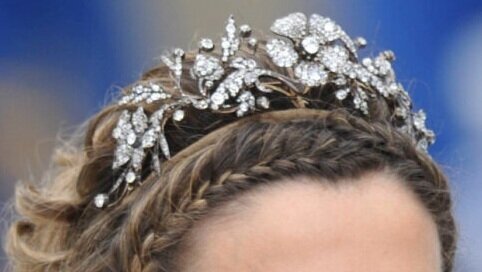
Queen Letizia floral tiara (1879, Spain)
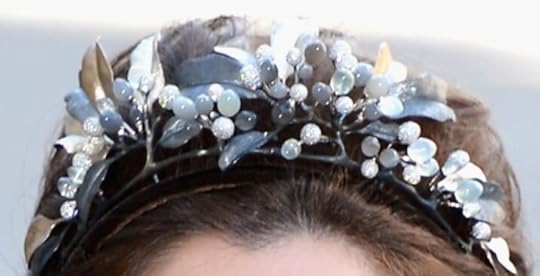
Princess Mary’s Midnight Tiara (2009, Denmark)
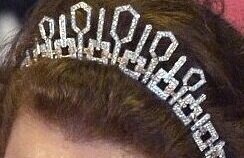
Princess Lalla Salma’s Tiara (2002, Morocco)
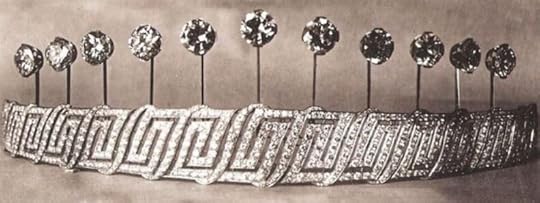
Part of the Nine Provinces Tiara (1926, Belgium)
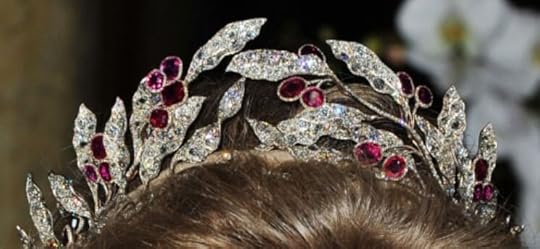
The Ruby Olive Wreath Tiara (~1870s-1880s, Greece)

Princess Hisako’s tiara (modern, Japan)

Princess Tsuguko’s tiara (modern, Japan)
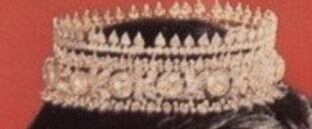
Queen Sirikit’s traditional tiara (1960, Thailand)
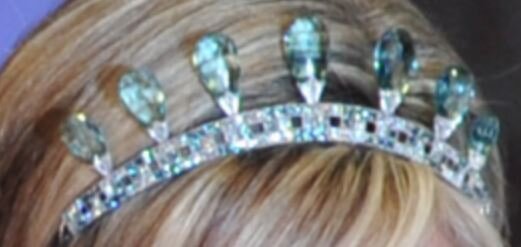
Dutch Aquamarine Parure Tiara (1927, The Netherlands)
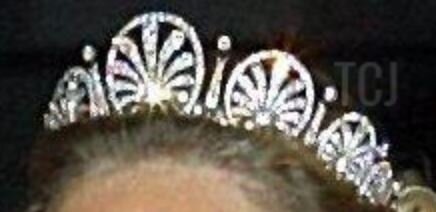
Kinsky Honeysuckle Tiara (1870, Liechtenstein)

Citrine and Pearl Tiara (~1980s, Luxembourg)
A couple of specific examples! These are all English/UK in origin because that’s the history I know most about and frankly, it’s way easier to find details and information on these then most of the others.
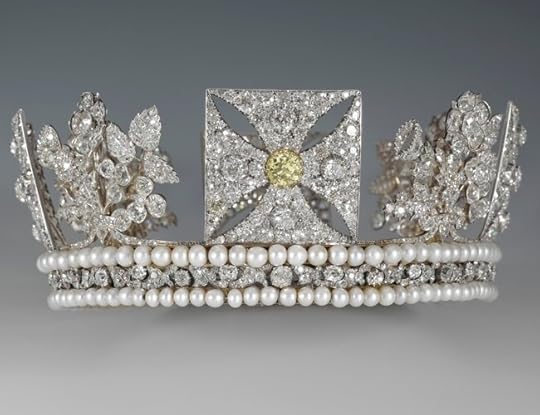
George IV State Diadem:
• Made 1820 to be worn by George IV during his coronation procession.
• Traditionally worn by Queen Consorts at coronations and the state openings of Parliament, but Queens Regnant Victoria and Elizabeth II have worn it as well.
• Gold and silver frame, with strings of pearls, 1333 diamonds (over 320 carats), including a 4-carat yellow diamond, positioned on alternating crosses pattée and florals. The four florals represent roses, thistles and shamrocks, the flowers of England, Ireland, and Scotland.
• Crosses Pattee – type of Christian cross that appears very early in medieval art – extremely common in crowns in Christian countries
• Open Crown, in which the the head is open to the sky.
• Commonly appears on stamps and currency.
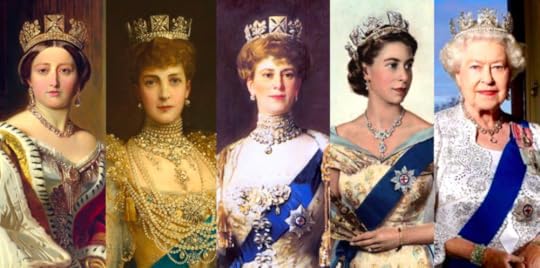
Queen Victoria, Queen Alexandra, Queen Mary, and Elizabeth II (both young and old), all wearing the diadem.
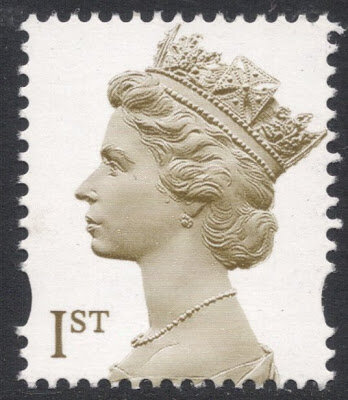
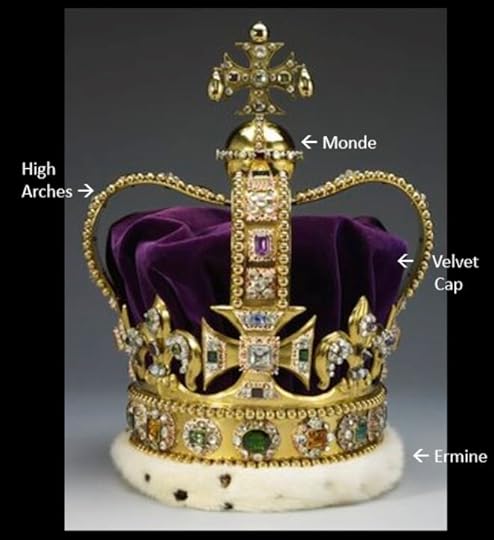
St. Edward’s Crown:
• First hereditary coronation regalia in Europe. The monks at Westminster Abbey claimed that Edward the Confessor asked them to look after his regalia for the coronations of all future English kings (although they probably just took it from his grave when he was reinterred there).
• A 1660 replica of Edward the Confessor’s crown, which was sold during the English Civil War. The medieval Crown dated to 1043. It was used in Richard II’s abdication in 1399, and was used to crown Anne Boleyn in 1533 (unprecedented for a consort).
• St. Edward’s Crown is 11.8 inches tall and 4.9 pounds. It’s made of gold, embellished with 444 stones, including amethysts, garnets, peridots, rubies, sapphires, topazes, tourmalines, and zircons.
•It has a closed Crown with high arches and a velvet cap trimmed in ermine
• From 1689-1911, monarchs chose to be crowned with a lighter, bespoke coronation crown personalized to each sovereign, while st. edward’s crown rested on the high altar.
• It’s currently used on royal arms of the UK, royal badges of England, the badges of the police forces of England and wales, the coastguard, british army, royal marines, royal airforce, and royal mail.
• This is a closed crown have bands around the temples and one or two bands over the head. Crowns with two bands or more usually for sovereigns; the prince of wales’ coronet only has one band. High arches in crowns are a symbol of sovereignty demonstrating that the king of England owed obedience to no one but God.
• The bottom is trimmed in ermine, which is very commonly seen in crowns, coronation cloaks, and peerage caps. Ermine comes from the winter coat of the stoat, which is a species of weasel with white fur and a black-tipped tail.
Imperial State Crown:
•Worn by the English monarch during the coronation when leaving Westminster Abbey and at the annual state opening of Parliament.
• A mere 2.3 pounds, compared to the 4.9 pound St. Edward’s Crown.
• It contains 2,901 precious stones, including the Black prince’s ruby and the Cullinan II on the front, St. Edward’s sapphire at the top, and the Stuart sapphire on the back.
St. Edward’s sapphire on the top cross is the oldest gemstone in the royal collection. Thought to have come from the coronation ring of Edward the Confessor from 1042.
Black Prince’s ruby – 170 carats = one of the oldest parts of the crown jewels, given to the black Prince in 1367. Henry V wore a gem-encrusted helmet that included this ruby. Mayyyy have been worn by Richard III on his helmet at the Battle of Bosworth, in which he died.
Stuart Sapphire on the back (lower left picture) – 104 carat - Probably belonged to Charles II and was definitely among the jewels that James VII took with him when he fled to France after the glorious revolution in December 1688.
• Fun fact: the arches are detachable, so the crown can also be worn as an open crown/circlet.

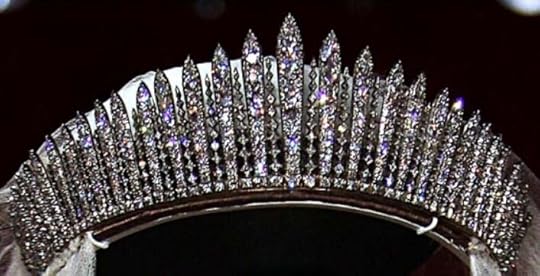
Queen Mary’s Fringe Tiara:
• The tiara’s diamonds came from an 1893 necklace and the tiara was made in 1919.
• Diamond fringe tiaras were incredibly popular after they became fashionable at the imperial court of the Romanovs. There are numerous fringe tiaras like this in the royal collection and many of them can also be worn as necklaces.
• Worn by both the Queen and Crown Princess Anne at their weddings.
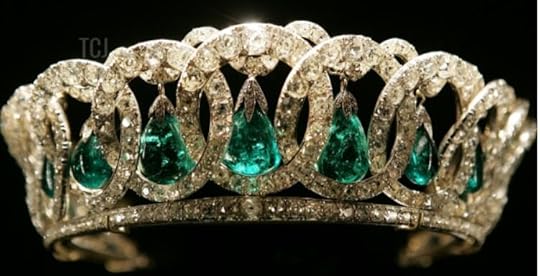
Vladimir Tiara:
• Originally owned by Duchess Marie, a German princess who married Grand Duke Vladimir Alexandrovich in 1874.
• When the Grand Duchess fled from Russia in 1917, her jewels, including this tiara, remained in a hidden safe in Vladimir Palace. Later, her son and his friend disguised themselves as workmen, sneaked into the palace, and smuggled out the contents of her safe. This tiara was later sold by her daughter to Queen Mary of the UK, along with numerous other Russian imperial jewels.
• It can be worn with hanging emerald or pearl drops or it can be worn “widowed,” that is, without any drops.
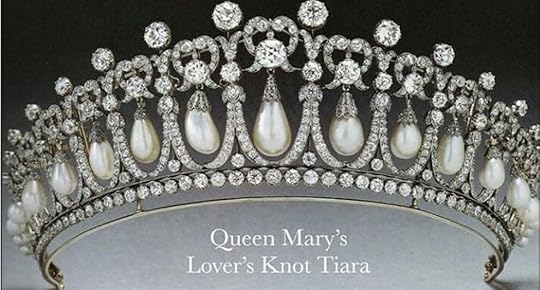
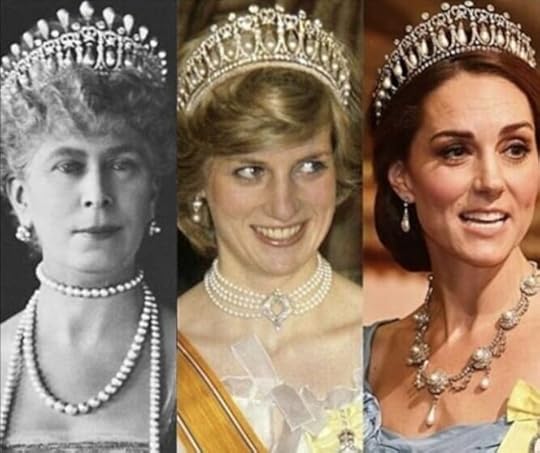
Queen Mary, Diana, Princess of Wales, and Kate, Duchess of Cambridge
Queen Mary’s Lover’s Knot Tiara:
• This tiara is commonly referred to as the Cambridge Lover’s Knot Tiara, but in fact, it was only based off of that tiara. Queen Mary had this tiara created as a copy of the Cambridge tiara, which was owned by her cousin, using elements harvested from several other tiaras in her existing collection.
• In 1981, when Prince Charles married Diana Spencer, Queen Elizabeth presented her with several pieces of family jewelry, including this tiara, as lifetime loans. Diana wore this tiara very often and it became highly associated with her. In more recent times, the tiara has been sported most often by Diana’s daughter-in-law, Kate, the Duchess of Cambridge.
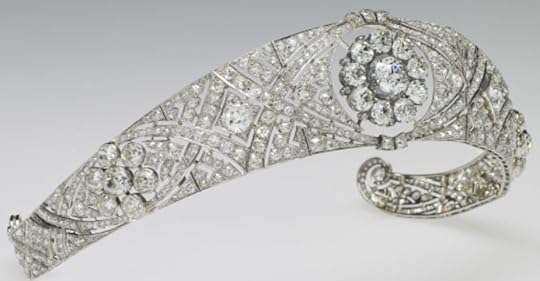
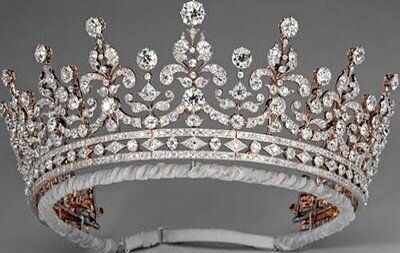
Queen Mary’s Diamond Bandeau (left):
• The Diamond Bandeau was made for Queen Mary in 1932 and specifically was made to feature the detachable brooch in the center. This brooch was given to Queen Mary in 1893.
• Meghan Markle wore the tiara for her wedding to Prince Harry in 2018. It was the first time the tiara had been worn in public in over 50 years.
• There are actually several tiaras in the royal family’s possession that haven’t been seen in public for 50-100 years!
The Girls of Great Britain and Ireland Tiara (right):
• The Girls of Great Britain and Ireland Tiara is one of the Queen’s most commonly worn tiaras.
• This was given to Queen Mary for her wedding in 1893 by a committee of women, which is where it gets its name. She presented it as a gift to then-Princess Elizabeth on her wedding day; the Queen still refers to it as “Granny’s Tiara.”
April 5, 2020
Diadems, Tiaras, and Crowns, Oh My!
So I’ve been hosting virtual lecture parties lately, since we’re all self-isolating and cooped up. At the most recent one, I presented on Diadems, Tiaras, and Crowns - talking about the different types and specific examples of each type. I had a lot of fun pulling together this slideshow and included as many pictures from around the world as I could. My specific examples though, are all English/UK in origin, as that’s my passion and it’s frankly just a lot easier to find information on these than many of the other crowns and tiaras out there.
I will be putting all the information into blog post format at some point, but that’s going to take me a while because - lots of formatting and image upload! For today, I’m just loading up the slideshow so y’all can look through it at your leisure. Enjoy! If you have any questions, feel free to ask; I love talking about this sort of stuff!
April 2, 2020
Details from Six Costume Designer Gabriella Slade's Instagram Takeover
Six Costume designer Gabriella Slade has taken over the @SixtheMusical Instagram for the day! I’m taking notes on everything she’s saying and throwing out a couple questions myself.
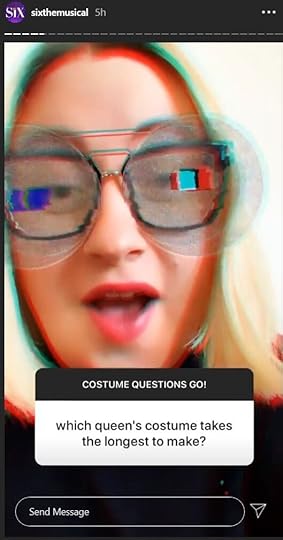
How she got involved in the production: About two years ago, Lucy Moss and Toby Marlow asked her to come in and do the costumes.
Tudor elements confirmed in the costumes: split pane sleeves, doublet references, corsetry, square necklines, a four part skirt, lots of latticework in the lacing.
Inspirations: For inspirations, she looked to Tudor portraits, paintings, and architecture. She also looked at modern fashion designers like Alexander McQueen.
Costume Making Process: The costumes take a few weeks to make. They do at least three fittings per costume and sometimes more, as the costumes are very complicated. The costumes are VERY heavy. The wardrobe supervisors for each show handle any alterations and mending. The most commonly needed fix is stud related, as they apparently fall off VERY often, even with the BEST glue in the world.
The queen’s costume that takes the longest to make: Catherine of Aragon’s! Most complicated costume in the show.
The queen’s costume that was the hardest for her to design: Jane Seymour costume was the hardest for her to design, as that character has a very different vibe from the rest of the queens. She said she needed a different visual language.
She’s not allowed to have favorite alternate costumes, however, she really enjoyed making the most recent pink costume currently worn by Zara in the WE production. There aren’t any purple costumes because it’s the brand color for six.
The boots are designed by Slade and are made by Laduca Shoes, specialists in dancewear.
Broadway Costume Changes: additional stud work, more latticework, just to enhance the initial designs from a few years.
Whenever a new cast comes in, she goes to see the show, so she’s seen it “loads of times.” Old costumes of cast members that have left the show are kept by the production and looked after on an archive rail.
Favorite detail about each costume: The many tudor and historical details in the costumes is so very important, even in contemporary fabrics.
She LOVES it when people cosplay the costumes. Whenever people do really brilliant ones that look like actual stage costumes, her team shares pictures of them all around. She also really loves the fan art of the costumes she sees online.
Suggestions for cosplays:
The costumes are super heavy so Slade suggests that cosplayers use “big chunky zips” on their creations.
Parr’s top has a zipper and a hook and eye closure.
Howard’s zip is on the center of the back of the bodice - the new broadway skirt has a side front opening instead of a center back one, as that helps the longevity of the skirt.
Miscellaneous:
Advice for students going into doing textiles for GCSE - need to keep up on new techniques and terminology.
Slade drinks tea all the time and she is a HUGE herbal tea fan.
March 30, 2020
The Historical Inspirations in Game of Thrones (will be updated regularly)
Plenty of people have written about the parallels between Game of Thrones and the Wars of the Roses before, but I’ve always been interested in how even the small details of the show align with history in some instances. I’ve talked about this numerous times with other English history friends and many of these examples come from those conversations. Many thanks to Leigh Beck for being my constant game of thrones history buddy!
Honestly, because there’s SO much, I’m going to keep adding to this post over many days and weeks, whenever I can. :)
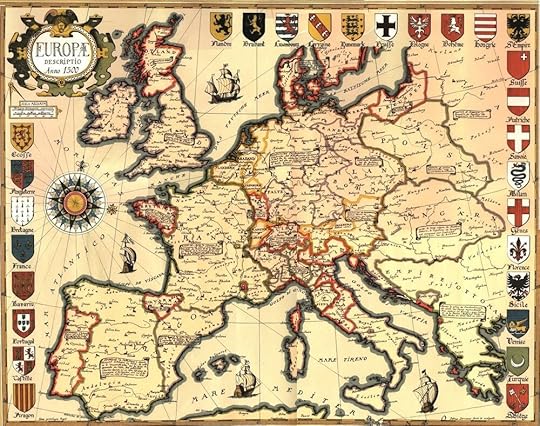
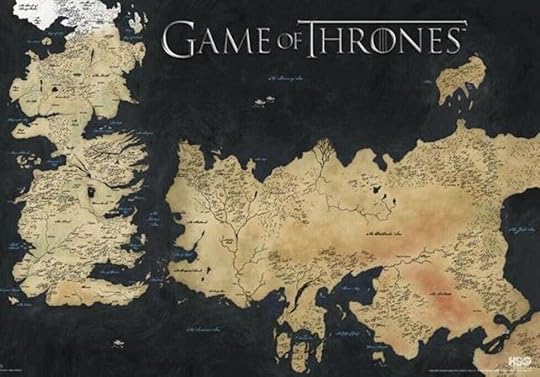
Overarching World-Building, Character, and Historical Things:
Westeros and Essos : England and Europe. Though Westeros is significantly larger than England, you can still see the similarities when you look at the maps side by side. Essos/Europe are both much larger than Westeros/England, and is where rival claimants (like Henry Tudor and Daenarys Targaryn) go to the throne to hide from the Westerosi/English king’s reach.

Hadrian’s Wall
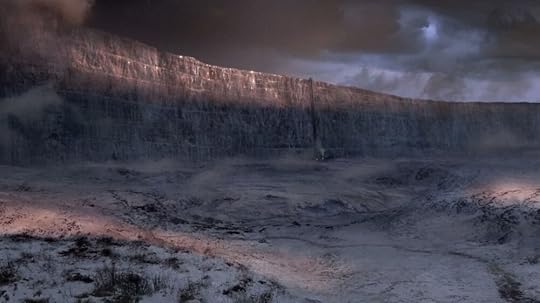
The Wall in HBO’s Game of Thrones
The Wall : Hadrian’s Wall. In Game of Thrones, the Wall runs for 300 miles along the northern border of the Seven Kingdoms from the sea on the west to the Bay of Seals and separates the realm from the domain of the wildlings who live beyond. In the story, it was constructed some eight millennia before. Historically, Hadrian’s wall was built by the Romans in AD 122 (so - ancient times) and runs for 73 miles, from sea to sea.
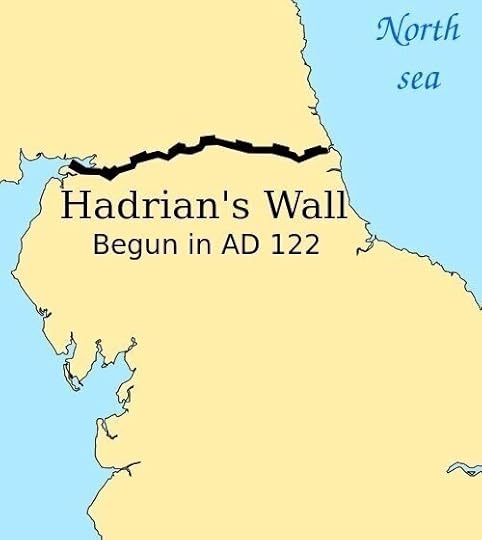
Hadrian’s Wall on a map of England.
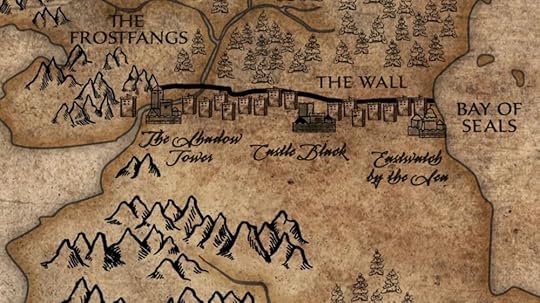
The Wall on a map of Westeros
Tywin Lannister : the Earl of Warwick, the Kingmaker. The way he married off his daughter Cersei to the new king he put on the throne, Robert Baratheon, closely parallels the way Warwick married off first his daughter Isabel to George, Duke of Clarence (Edward IV’s brother) when he tried to put him on the throne, and then his daughter Anne to Edward, Prince of Wales (the son of Henry VI and Margaret of Anjou), when he put Henry VI back on the throne.
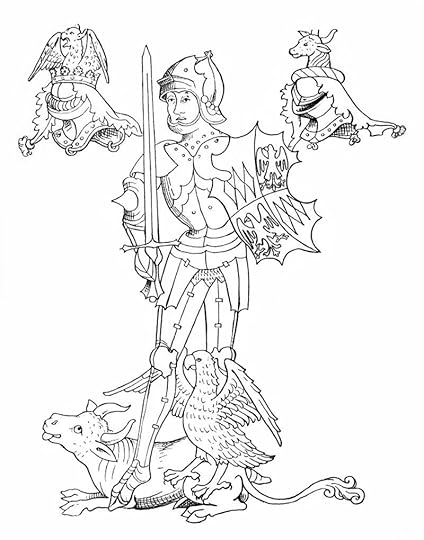
Richard Neville, Earl of Warwick (The Kingmaker)

Tywin Lannister in the TV series
Jaime Lannister : Richard, Duke of York (in one context) - In the flashback, it’s described that Jaime Lannister specifically was sitting on the throne when Ned Stark came in during Robert’s Rebellion; Ned was appalled, because he didn’t have a right to the throne at all. This can be seen as a parallel to when Richard, Duke of York (Edward IV’s dad) placed a hand on the king’s throne and appalled EVERYONE in the room.
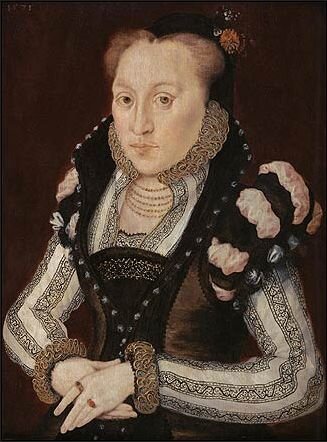
Lady Mary Grey
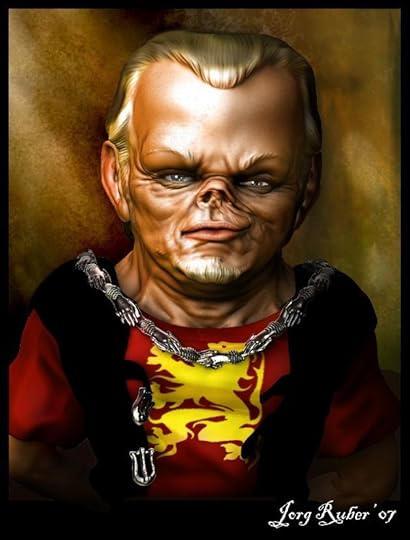
A rendition of Tyrion Lannister as described in the books, by Jerg Ruber on Deviantart.
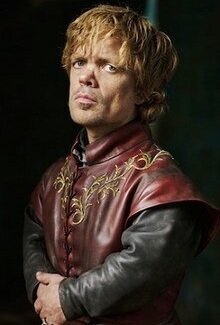
Tyrion Lannister in the TV show (Peter Dinklage)
Tyrion Lannister : Mary Grey - Tyrion is the youngest child of a very important family in the kingdom and is referred to throughout the books as a dwarf. Mary Grey (1545-1578) was the youngest child of the Greys, who had a claim to the English throne (her sister Jane Grey was the “8 days queen”), and was also likely a little person. Mary was described by a Spanish ambassador as “by the Spanish ambassador as “little crook-backed, and very ugly.” Similarly, although Tyrion is very handsome in the TV show (because Peter Dinklage is GORGEOUS) , in the books he’s portrayed as significantly less so. This picture from Deviantart portrays book Tyrion really well.
In the books and TV show, it’s related that Tyrion once impulsively married a commoner woman named Tysha in secret; his father punished both him and the woman rather severely for it. Although Mary’s older sister Katherine Grey had married in secret and been fiercely punished for it by Elizabeth I (who didn’t want anyone in line to the throne to get married without her approval, which she was unlikely to give), Mary herself eloped with the Queen’s sergeant porter Thomas Keyes. Keyes was only minor gentry, while Mary was in one of the highest ranking families in the country, and he already had 6-7 children. He also apparently was about 6 feet 8 inches tall, while Mary was described by the Spanish ambassador as “little crook-backed, and very ugly.” Once the Queen found out about the wedding, Mary was put under house arrest and Keyes was committed to the notorious Fleet prison. They never saw each other again.
Aegon Targaryen : Henry VI - Decent parallel for Henry VI, the Mad King whose madness started the war over the throne to begin with, although Henry VI was a very pious man whose "madness" took the form of basically being catatonic for several months, while Aegon liked burning and torturing people randomly.
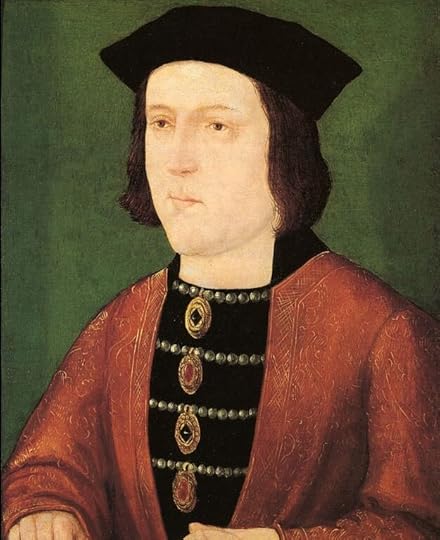
Edward IV
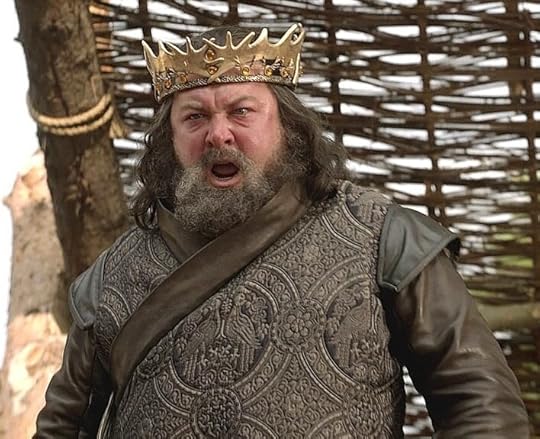
Robert Baratheon in the TV show
Robert Baratheon : Edward IV, a young, promiscuous man who leads a rebellion and takes over a kingdom from the mad king.
He and his two brothers Stannis and Renly are a good parallel for the three sons of York- Edward, George, and Richard. Renly's marriage to Margaery Tyrell (the daughter of a very powerful and rich house) can be seen as a reference to George marrying Isabel Neville right before rebelling against his brother Edward.
Stannis and Renly revolt against Joffrey partly over fears that he's a bastard. There were many rumors that Edward IV was a bastard, a result of his mother's supposed affair with an archer. In addition, Edward IV’s children with Elizabeth Woodville were declared bastards due to their father’s supposed previous marriage to another woman, giving legitimacy to Richard III’s claim to the throne.
The Old Gods of the Forest : Celtic polytheism
The Faith of the Seven : Roman Catholicism - Though the faith of the seven is described as polytheistic, while Christianity is monotheistic, the concept of the Trinity is a good parallel to the faith of the seven. Both religions have traditional places of worship with elaborate architecture and decoration, specific religious ceremonies to recognize marriages and births, a supreme religious leader believed to have a a special connection to god (pope/high septon), a holy book, hymns and a specific liturgy, ceremonial garb. They also both unfortunately feature often corrupt priests.
The Lord of Light : Zoroastrianism
Season 1 Plots and Details:
Cersei : Anne Neville, daughter of the kingmaker who ends up becoming queen herself
But also, Cersei : Margaret of Anjou, smarter and fiercer than her husband, ends up leading battles and killing lots of people for the rights of her son (who was portrayed as being rather sadistic in at least some fictionalized versions of history I've read, which are often based on at least rumor)
Cersei: Elizabeth Woodville, the wife of the Edward IV analogue, from a social climbing family, very close to her brother. A powerful adversary who is fiercely protective of her children (even though they are accused of being illegitimate). In this metaphor, Tyrion is the Richard III character she sees threatening her children.
Finally, Cersei : Anne Boleyn - Her affair with her brother can be compared to the conviction of Anne Boleyn for incest with her brother (which was almost certainly 100% made up by her enemies).
Renly Baratheon: George, Duke of Clarence - Both Renly and George, Duke of Clarence thinks they should be king, just because. Both have to be put to death by his brother for the sake of the realm (Clarence was executed by Edward IV after he’d rebelled against him a few times, accused the queen of witchcraft, and hired a sorcerer to foretell the king’s death, which was highly illegal).
Toward the end of season 1, Renly offers to give Ned men so they can take Joffrey away from Cersei ASAP before Robert dies. This is similar to how Richard III took Edward V away from his mother's family after the death of his father Edward IV. Most of the time when there was an underage monarch suddenly on the throne there would be a major power struggle and often one of the leading players would be the new king’s mother. Elizabeth Woodville/Edward V and Margaret Tudor/James V of Scotland come to mind.
This situation is exactly what Henry VIII was trying to prevent when he chose not to appoint a lord protector for Edward VI but instead had a whole Council of Regents...and that lasted all of 6 seconds before there was THE FIRST coup to be Edward's regent. My advice is to always get the king in your possession ASAP. If you have the child King under your control then you're all set. Ned failed and paid dearly for it.
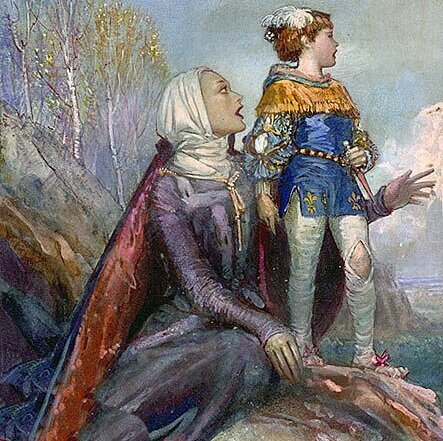
Magaret of Anjou and her son Edward, Prince of Wales
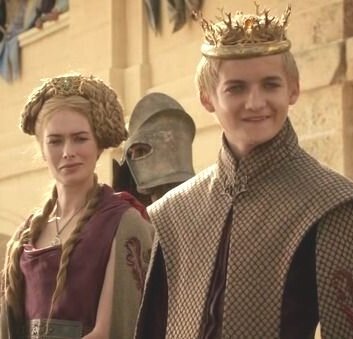
Cersei and her son, King Joffrey
Joffrey : Edward, Prince of Wales (son of Henry VI and Margaret of Anjou) - After the second battle of St. Albans in 1461, Cersei had the two Yorkist men who had guarded her husband Henry VI throughout the battle executed (although the king had promised them immunity). It has been alleged that she had her son, who was then 8 years old, decide what to do with the men; he replied that they should be decapitated.
Similarly, Cersei had her son Joffrey (who became king at 12 in the books and 16-ish in the TV show) decide what to do with Ned Stark after Ned confessed to treason and acknowledged Joffrey as the true king. Although Cersei wanted him to spare Ned’s life, Joffrey ordered him decapitated.
Ned Stark : Richard of York - Just as Ned Stark was killed by an angry queen and her young son, Richard, Duke of York, was beheaded by the forces of Margaret of Anjou, who was fighting to keep her son in line to the throne (a previous peace between the Yorks and Lancasters had been negotiated by having Henry VI name Richard of York his heir). Both Ned’s and Richard’s heads were displayed on a gate or wall after their executions.
Season 2 Plots and Details:


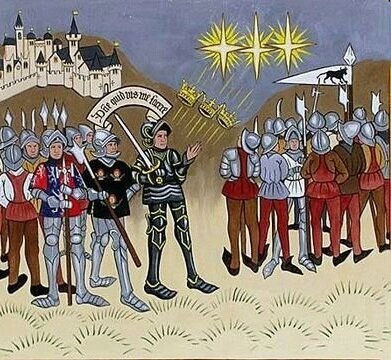
The Parhelion over the battle of Mortimer’s Cross
Red Comet : Solar Eclipse - In the book, a red comet appeared in the sky right after Ned Stark was executed, which was seen by all of the viewpoint characters and described and interpreted differently by all of them. Historically, a full solar eclipse occurred on the day that Anne Neville, Richard III’s queen died. It was considered a bad portent for Richard’s reign and he lost at the Battle of Bosworth a few months later.
Another astrological phenomenon known as a parhelion, in which three suns appear in the sky, also occurred immediately before the Battle of Mortimer’s Cross in 1461. Edward, Earl of Rutland, the future Edward IV, convinced his troops that it was a good sign for their cause.
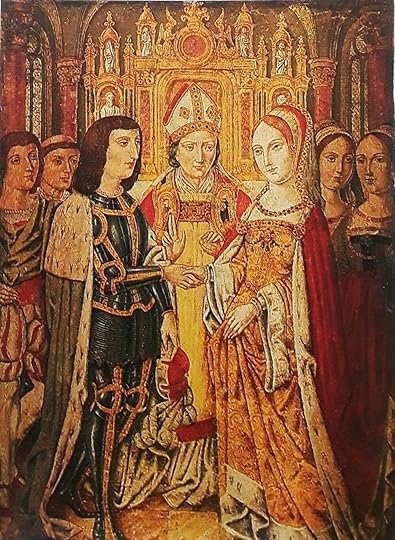
Edward IV and Elizabeth Woodville
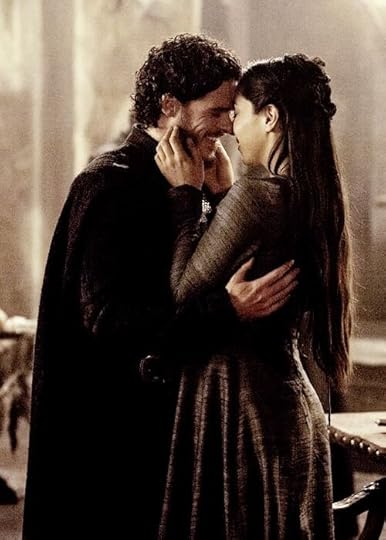
Robb Stark and Talisa Maegyr
Robb Stark : Edward IV - The son of an executed powerful man (Ned Stark/Richard, Duke of York) young claimant who everyone underestimates until he wins all his battles. Both Robb and Edward IV also went against their planned marriage to marry an unplanned, unsuitable match for love (Edward IV marries Elizabeth Woodville even though Warwick was trying to arrange him a marriage with a princess of France, Robb marries Talisa in the TV show for love and Jeyne Westerling in the books for honor even though he was already promised to wed one of Walder Frey’s daughters).
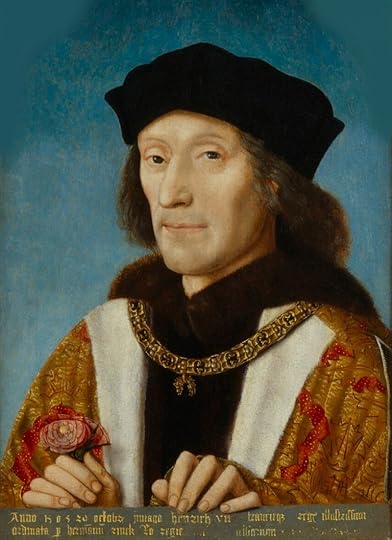
Henry VII
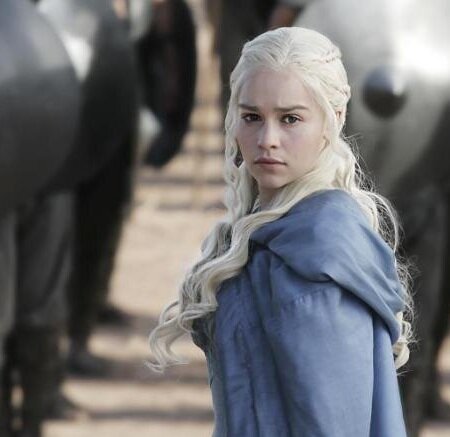
Daenarys Targaryen
Daenarys Targareyn : Henry Tudor/Henry VII. The last of her line after the death of her brother, both of them were raised to believe they were the rightful heirs to the throne. Interestingly enough, both Daenarys and Henry used dragons as their sigils; Dany because of her family’s history with actual dragons, and Henry because of his roots in Wales. In addition, just as historically, numerous people fleeing from Richard III joined with Henry Tudor over the sea, several men who left Westeros joined with Dany to help her get the throne.
But also Daenarys Targareyn : Elizabeth I - One of the first female claimants to the throne, someone no one expected to get to the throne, and also a woman incapable of or unwilling to have children, making succession discussions a touchy subject!
Season 3 Plots and Details:
Theon Greyjoy : Henry Tudor -Theon, the heir of a known rebel, was raised in the house of his family’s enemies, The Starks, as one of their own. Similarly, Henry Tudor, the Lancaster heir, was raised by the Yorkist Herberts as part of their family for about 8 or so years after his uncle/guardian Jasper Tudor fought against the Yorks.
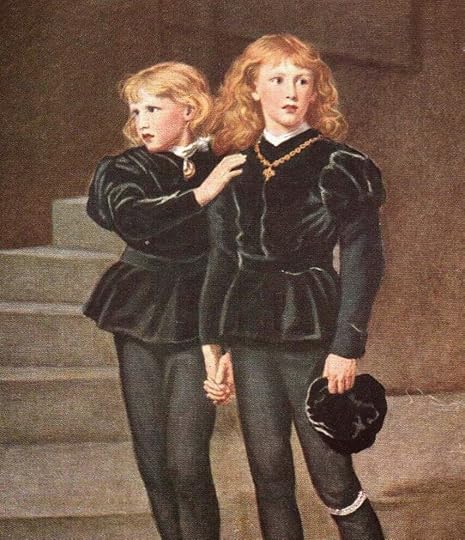
The Princes in the Tower
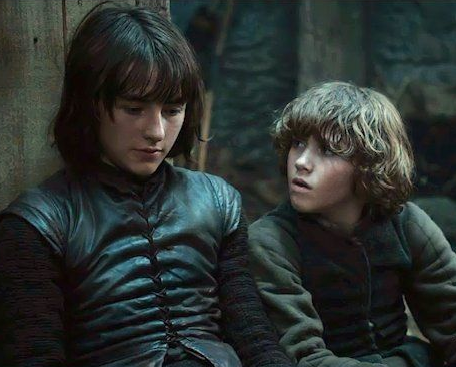
Bran and Rickon in the TV show
Bran and Rickon Stark : Princes in the Tower (Edward V, King of England, and Richard of Shrewsbury, Duke of York) - Young boys of a renowned family whose very existence proved a threat to others who wanted to take their family’s thrones/castle. Bran and Rickon escaped Winterfell when Theon and the Ironborn captured it; Theon burned the bodies of two commoner boys and showed them to the people. The fate of Edward V and his brother Richard is still a historical mystery; they disappeared and no one really knows where they went or what happened to them.
Season 4
Tommen : Henry VIII - the much younger brother of the previous heir to the throne who married his brother’s widow (Catherine of Aragon/Margaery Tyrell).
Tywin Lannister : the Earl of Warwick, the Kingmaker - Rounding back to this theme from earlier, Warwick died in battle with Edward IV, with whom he was very close and who he put on the throne, after betraying him by rebelling against his rule (twice). Tywin was killed by his son Tyrion, after betraying him by sentencing him to death for the murder of Joffrey (which he didn’t commit) and sleeping with Tyrion’s beloved lover Shae.
Season 5
Tommen : Edward VI, child king who brings in a new harsher form of religion. In Tommen’s case, this was the Sparrows. In Edward VI’s case, it was a conservative form of Protestantism. Both religions were led by persuasive, dynamic figures who removed a lot of the pomp and decorations from the previous religion and sought to get rid of corruption in the religious leaders.
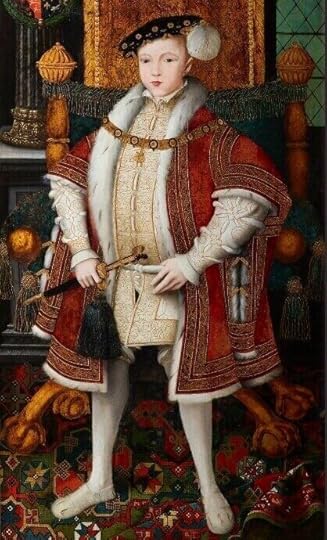
Edward VI
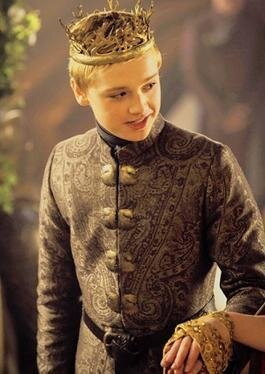
Tommen Baratheon in the TV series
Margaery Tyrell : Anne Boleyn - Her closeness to her brother and tolerance for his sexual habits (considered abnormal by the church) could be compared to Anne Boleyn's closeness with her brother George, with whom she was falsely convicted of committing incest. Margaery too, was punished for her closeness with her brother, in her case, knowing about his homosexuality and not reporting it to anyone.
The yellow rose of Tyrell : the white rose of York likely (the red rose of Lancaster wasn't really used much contemporaneously, although they did occasionally use a golden rose apparently).
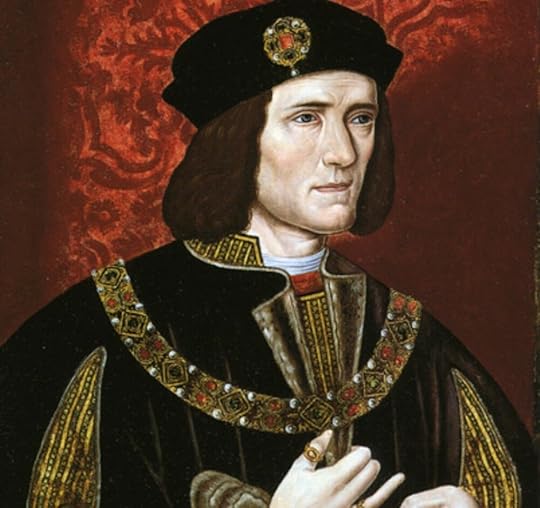
Richard III
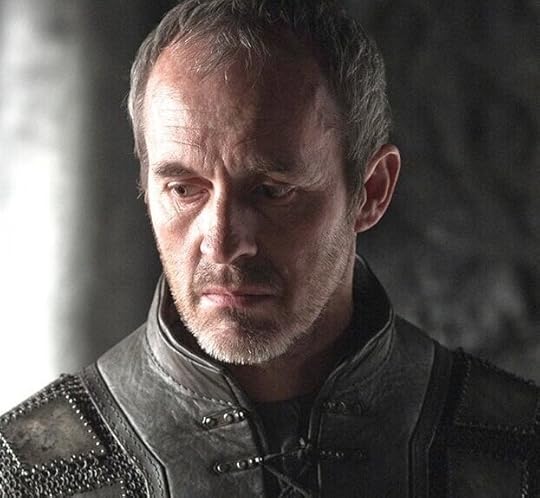
Stannis Baratheon in the TV show
Stannis Baratheon : Richard III - Both men believe that they are the rightful heirs after their deaths of their brothers (Robert Baratheon/Edward IV), as the royal children are/are supposedly illegitimate. Both men were supported by lots of people until the murder/disappearance of a child (princess sheeren/ the princes in the tower, although I should note that no one knows what happens to the princes in the tower). Both were very religious and devout and loyal - up to a point.
March 22, 2020
Henry VIII and his Six Wives: Paperdoll-Style!
I didn’t plan on making a video retelling of Henry VIII and his six wives using paper dolls today but well, here we are. Self isolation makes you do weird things!
Paper dolls are by Tom Tierney.
Music by me, arrangement by Pat Qualls and Becky More (originally for harp and handbells).
March 13, 2020
The Historical Influences of the Costumes of & Juliet: Part 2
Part 1 of this series is up here !
& Juliet is a 2019 musical now up in the West End in London that starts off at the end of Romeo & Juliet. Instead of killing herself, Juliet survives, and runs off to Paris with some friends to avoid being sent to a convent by her parents. Shenanigans ensue. There’s also a frame story about William Shakespeare and his wife, Anne Hathaway (no, not that one) arguing over how to plot out the story. All the songs in the musical are by Max Martin and were previously big pop hits; think “I Want it That Way,” “…One More Time",” “It’s Gonna Be Me, “Blow,” and other songs by Backstreet Boys, Britney Spears, NSync, and several other artists.
I’m not SUPER familiar with the musical, but I’ve listened to a bit of the soundtrack, have read through the WIkipedia page, and have seen some awesome photos of the costumes, which mash up renaissance and modern elements. So of course, I want to go through and analyze some of the costume elements through the lens of Tudor history. I’m not going to go AS in depth with these costumes as I previously have with Six, because & Juliet has WAY more than six characters and plenty of those characters seem to have several costumes. I’m also sure I won’t be able to get all the costumes, so I’m honestly not going to fuss about it too much.
Although Romeo and Juliet technically takes place in Italy, and most of this musical takes place in France, the costumes seem to be far more English renaissance inspired; there were a lot of similarities in renaissance dress in these three countries, but also some pretty striking differences.
FYI: A fair amount of the explanation of the different elements is borrowed from my previous post on the Tudor fashion elements of the costumes in Six the Musical.
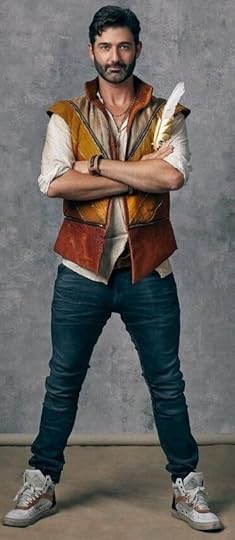
William Shakespeare
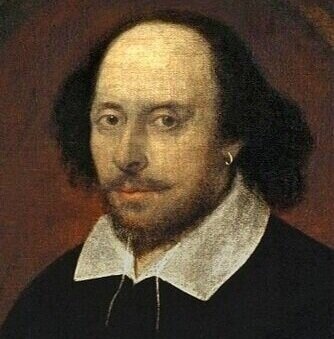
William Shakespeare
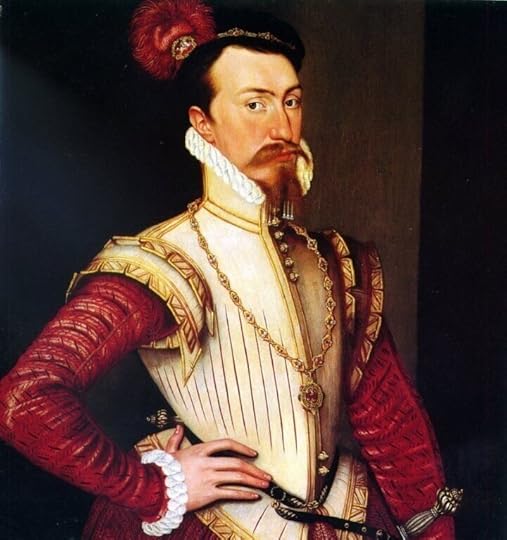
Robert Dudley, Earl of Leceister
William Shakespeare (Oliver Tompsett) - Will’s wearing an undershirt, a vest with a high collar and some very distinct diagonal line cuts, and slim cut jeans that resemble Tudor hose. It’s all rendered in a very Tudor color scheme. Because Shakespeare was an actual historical figure and we have SOME portraits that purport to be of him, it’s possible that this costume was loosely based on one of them. This is one of the more famous ones, and it certainly looks like there’s some inspiration - the coloring in the costume vest and shoes is similar to the mustard yellow background of the Chandos portrait. the white under tunic also looks pretty similar. He’s also sporting a beard.
As you can see in the portrait of Robert Dudley (Elizabeth I’s favorite), high collars and diagonal lines, and vests with cap sleeves were all commonly seen in Elizabethan fashion. Shakespeare was an active playwright from at least 1585-1613 and died in 1616. Elizabeth was on the throne from 1558-1603, after which time her first cousin twice removed (the great-grandson of her father Henry VIII’s sister Margaret Tudor) , James, became king of England.
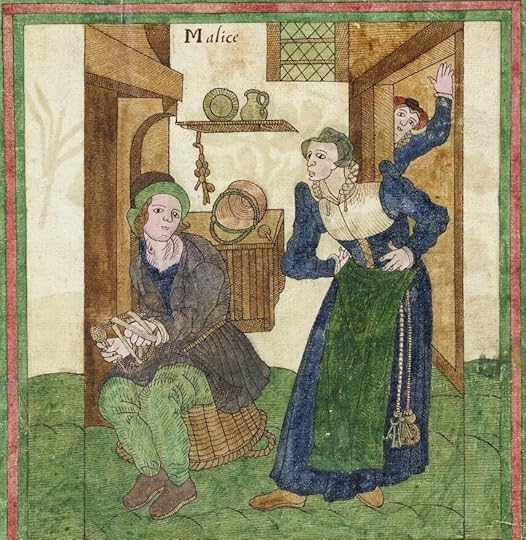
This peasant man is wearing hose that are much baggier than those often seen worn by nobles. Trevilian Miscellany, 1602
Hose - Hose were undergarments covering the full length of the legs for a long time. They were probably made to measure by a hosier and cut on the bias to allow the cloth to stretch. However, in the last quarter of the 15th century, fashionable young men in Italy began to omit the gown or tunic traditionally worn over their hose and doublet. This resulted in the development of the codpiece (discussed further down in the post), as previously, each leg of a man’s hose was separate, as it wasn’t visible, and thus left a gap around the crotch area.
Tight fitting hose and doublets that rose above the hips were popular in England in the first half of the 16th century, although the trend quickly moved toward wearing gowns over the doublet and tunic, which revealed the hose and codpiece beneath those layers, but widened the figure into the fashionable male silhouette inspired by Henry VIII’s own generous size.
Hose was sometimes very tight and close fitting, particularly among upper classes that could afford the type of cloth and tailoring required for such looks, but lower class folks often had baggier hose.
Beards- Beards were unfashionable for a long time in England, as Henry V chose to go beardless and EVERYONE wanted to be like Henry V. His son, Henry VI, his son’s successor, Edward IV, HIS successor, Richard III, and HIS successor, Henry VII allllll went beardless.
However, Henry VIII brought the beard back into vogue during his reign. He was clean-shaven for the first two decades or so of his reign, but grew a beard after promising the French that he would not shave his beard until he met the King of France at the Field of Cloth of Gold; the King of France made the same vow (Fun story: Catherine of Aragon hated her husband’s beard enough that he eventually shaved it off, which caused something of a diplomatic debacle, until his French ambassador, a charming fellow named Thomas Boleyn, managed to persuade the French King’s mother that “Love is not in the beards, but in the hearts.”)
Apparently even after the field of cloth of gold, Henry liked his beard enough to keep it, and sports it in his most famous portrait. It became fashionable again, and was VERY popular by the time of his daughter Elizabeth’s reign, during which Shakespeare lived. In fact, beards were cut in numerous different styles, which apparently were sometimes distinct enough for them to signify a specific profession (which must have been very useful for actors on stage - based on the styling of their beard, audiences could recognize them as a bishop, clown or what have you!). They were often styled with starch, which was a similarly popular fashion element for ruffs, which are discussed later in this post.
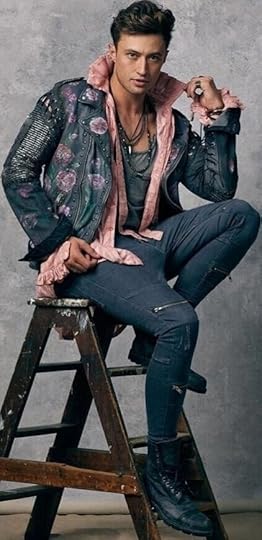
Romeo
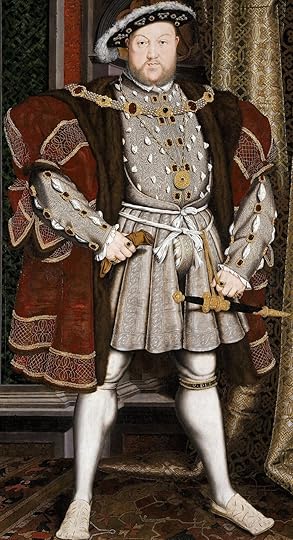
Henry VIII. In case you didn’t know that.
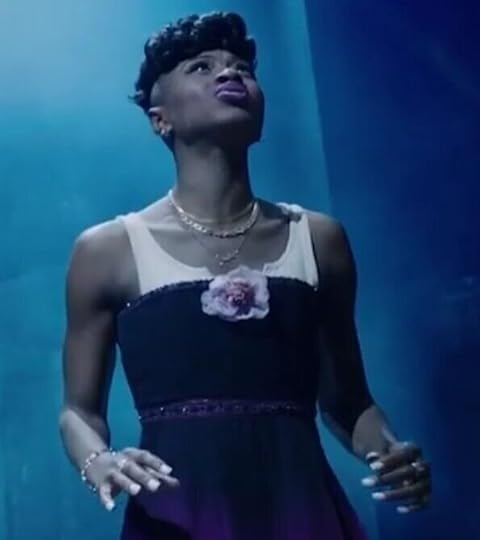
I don’t know for sure, as I haven’t seen the show, but I believe this is Juliet’s dress when she finds Romeo’s dead body. At this point, her pink flower and color scheme match Romeo’s jacket.
Romeo (Jordan Luke Gage) - Believe it or not, Romeo’s outfit follows a lot of the same guidelines as Henry VIII’s outfit in his famous portrait. He’s got an undershirt, an overshirt, an overcoat, tightly fitting jeans resembling hose with zipper details that resemble garters and/or embroidery details, decorative (and detached) sleeves, ruffled shirt cuffs, and several necklaces and rings. He’s also sporting nice black boots with leggings tucked into them (that look BARELY used compared to most character’s very scuffed up shoes. I HAVE to figure out the meaning of these shoes - does it indicate life experience?).
He wears a pink shirt and his coat is covered in pink roses, probably representing his typically romantic worldview. His outfit also matches Juliet’s dress at the beginning. It looks like there’s writing on his jacket as well? This could be referring to his role as a play character.
Undershirt/overshirt - I didn’t discuss this in my first post, really, but undershirts in Tudor times were really a practical solution to the difficulty of washing a lot of the finer clothes of the day. The thin shirt by your skin absorbed up most of your sweat and was significantly easier to launder.
Detached sleeves - Detached sleeves that could be removed or attached by lacings to the body of a shirt or dress were common in both men and women’s garments, as it gave wearers options for changing up their style. The detached sleeve really began to develop in the 1480s and peaked around 1525 (according to “What People Wore When”).
Garters - The zipper details on Romeo’s pants could be meant to resemble garters, which you can see in Henry VIII’s portrait at right. Garters were worn by men and women to hold up hose, as elastic hadn’t been invented yet. These could be made of leather, fabric, or ribbon and were often tied below the knee to support the hose. You can see Henry VIII’s garters in his portrait above.
Embroidery - Since almost every young girl in Tudor Society was taught to work with a needle, and pretty much every noble lady could embroider, embroidery was very commonly seen in the clothing of nobles. You can see many different examples in the portraits I’ve shared throughout this post.
There were sumptuary laws that restricted what color and type of clothing and trims could be worn by people of various ranks; embroidery was pretty much only allowed for nobles or knights (were the Montagues nobles in Romeo and Juliet? perhaps. But the actor playing Romeo in Elizabethan England sure wouldn’t have been). However, sumptuary laws were relaxed onstage, and actors could wear clothing that they’d be banned from wearing otherwise, as long as they were performing in a play at the time.
Bling - Men wore just as much bling as women did in Tudor times! Here, you can see Romeo sporting a necklace and at least one ring, maybe more (it’s hard to see). In his portrait, you can see that Henry VIII is wearing at least two necklaces (the large one looks like his collar of office) and three rings, as well as jewels incorporated into this hat decoration, the buttons and decorations on his sleeves, and even in his knife’s scabbard. Records indicate that Henry VIII sometimes wore a ring on every finger.
Although jewels in jewelry was generally confined to noble classes, as these were quite costly, lower classes still commonly wore jewelry made of glass, bone, or wood. Gold jewelry was apparently popular with all of the classes as well.
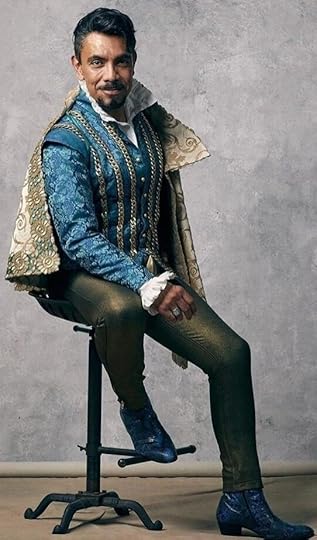
Lance
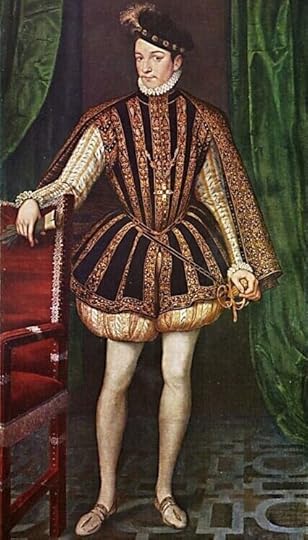
Charles IX of France, who reigned from 1560-1574. By François Clouet.
Lance, the King of France (David Bedella) - Lances’ outfit is actually very close to renaissance fashion except for the jeans. He’s sporting an under shirt, a blue doublet festooned with gold chains, and a heavily embroidered cape. His slim cut jeans closely resemble hose. His blue boots are totally glorious (and entirely unscuffed) and look like they’ve got some sort of delicate design over them.
It’s interesting that he and Angelique are the characters who sport the most Tudor fashions, and it looks like they might end up together in the end.
Cloak/cape - Although overcoats were more popular in Henry VIII’s time, short capes that fell to the hips were fashionable in the later part of the 1500s. The cape (and shirt) that Lance wears in the musical resembles the one in the portrait of Charles IX I’ve included on the right, which is similarly festooned with intricate detailing. The one Lance is wearing is worn over the shoulder and held in place by the hand, serving both a practical and a fashionable purpose.
Blue - Both Lance and Francois are wearing blue, which is a traditional symbol of France that’s been found in French flags and heraldry for centuries.
Boots - In the renaissance, men and women wore similar flat shoes with rounded toes. The shoes were often made of silk, velvet, or leather. Duckbill shoes were pretty fashionable in Henry VIII’s time, as you can see in his portrait above, but were out of fashion by Elizabethan times and were back to narrow toes then.
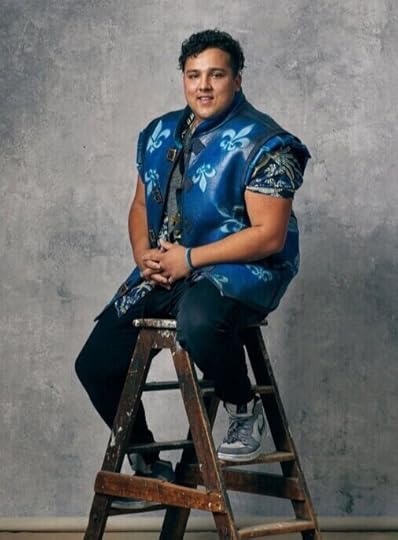
Francois
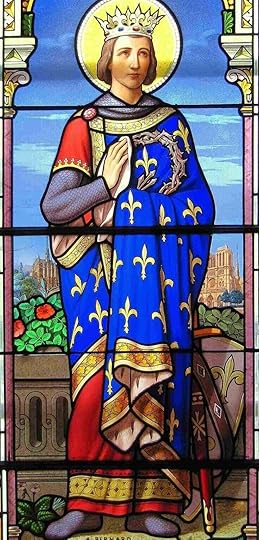
Louis IX of France, who reigned from 1226-1270.
Francois, the Prince of France (Tim Mahendran) - Francois is wearing a short sleeved undershirt, a long robe covered in fleur-de-lis, and slim cut jeans which resemble hose. Everything is blue, naturally, because France.
Fleur-de-lis - The flower symbol known as the fleur-de-lis, referring to the flowers growing by the Lys river in France, is very old, and has appeared in artwork dating back to ancient times. The fleur-de-lis was stamped on Gaulish coins from around 100-50 B.C. and has been used as a symbol by all the Christian Frankish kings.
Long Robe - Francois’s fleur-de-lis covered blue vest looks like it was perhaps inspired by French ceremonial robes and fabrics worn by MANY monarchs (seriously, I found so many paintings of French monarchs wearing blue fabric covered with fleur-des-lis, although those were usually yellow, instead of Francois’ light blue); I thought this stained glass window of Louis IX had the most similar positioning of fleur des lis on the fabric to the & Juliet costume.
This type of longer surcoat (outer tunic), which fits closely to the body, but has no defined waist, and goes down to the hips, was seen more in the early 15th century and wasn’t really very fashionable by Tudor times. In Henrican times, surcoats were much wider than this, and in Elizabethan times, they generally had a much more defined waist. That’s another reason I think this costume was really based off of depictions of French royal ceremonial wear, rather than portraits, which reflected modern fashion more often.
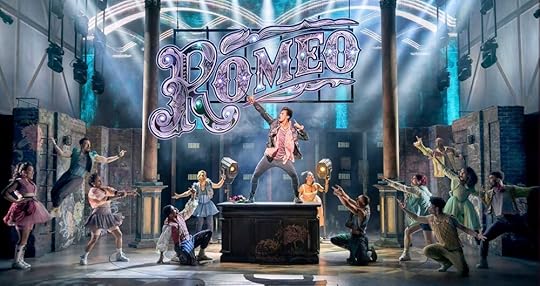
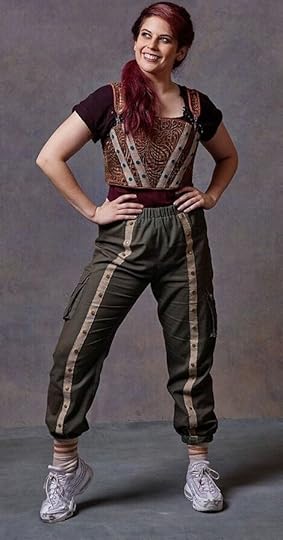
Imogen
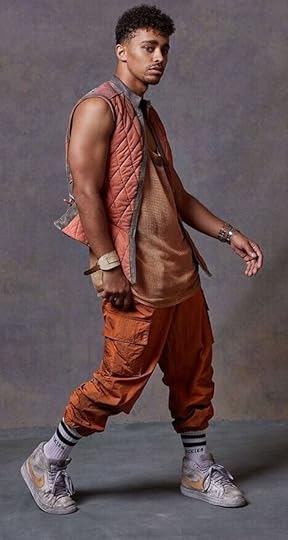
Augustine
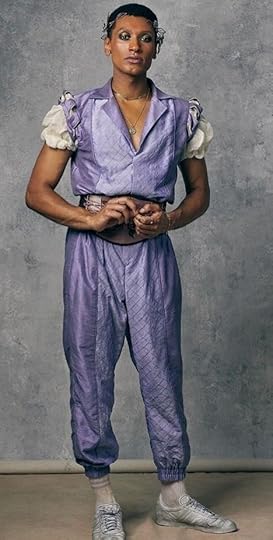
May
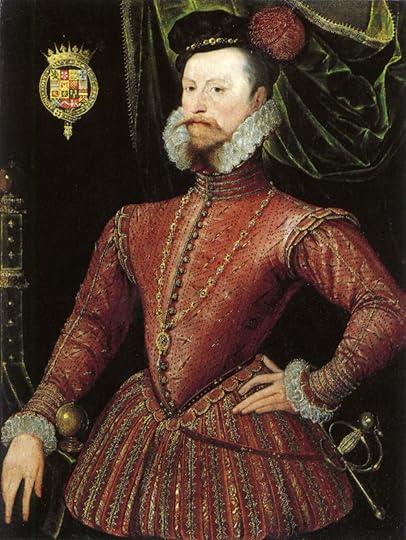
Imogen (Rhian Duncan) - Imogen wears clothes that are inspired by both female and male Tudor fashions. Her top clearly is based on a corset with stays, with an undershirt under it, and her pants are based on some of the baggier hose variations, with decorative lines down the front and studded designs.
I’ve noticed that the characters in &Juliet that are less likely to be nobles seem to wear much baggier pants than the royals. You can see this in nearly all the rest of the photos in this post.
Boning/Stays - The supportive looking lines in Imogen’s top refer to boning within dresses and supportive stays. These aren’t overtly Tudor, as they’re generally associated with later time periods, and I unfortunately don’t have any painting references for this because they were explicitly /underwear/ and not something that would show up in art, but we do know that whalebone was used for support in women’s garments at least by the time of Elizabeth I’s death, as her effigy wore a corset containing whalebone.
These diagonal lines on the costumes help evoke the ideal Tudor silhouette of a inverted triangular waist (see the portrait at right for an example. You can also see this in many portraits of Elizabeth I) without actually requiring the actor to wear such a body shaping garment.
Studs - The metal studs in the pants resemble those seen in Brigandines, a type of historical armor. Brigandines are made of heavy cloth or leather with steel plates riveted to it, and are pretty distinctive, with visible metal studs on the front.
Augustine (Antoine Murray-Straughan) is wearing a quilted vest with baggy pants resembling hose.
Quilted vest - Quilted cloth was actually commonly used by soldiers, either alone or under armor. One type of Medieval European armor called the jack of plates (or coat of plates) actually looked like a quilt, but had small iron plates sewn between layers of felt and canvas. Although jack of plates were used in Medieval times, they were worn through the 16th century.
If you’ve read my Ladies in Waiting of Six post, you may notice that this garment sounds similar to the brigandine I described there. The main difference is that the plates in a brigandine were riveted into place between the cloth layers, rather than sewn, so metal studs were generally visible on the outside. A jack of plates has its metal bits sewn between cloth, so you’re not going to see metal on the outside of that.
May, Juliet’s non-binary friend (Arun Blair-Mangat) wears what looks like a single piece jumpsuit with a quilted design all over it and a leather belt over it. I’m pretty sure jumpsuits weren’t a thing back then, but the shapes of the clothing are very similar to some of the undershirts and baggy hose that I’ve talked about elsewhere in the post. This outfit is actually very similar to renaissance male clothing, but the color is a bit more feminine to modern eyes. It’s a very unusual color for Tudor times, as you usually don’t see purple clothes at all in paintings from back then (I looked. a lot), and definitely not this light lavender look. It’s so pretty!
It also looks like May’s wearing a flower/butterfly crown. Although you see flower crowns everywhere at renaissance festivals, I couldn’t find any in actual paintings from that time period. Flower crowns have such a long history in multiple cultures though, that I’d be surprised if they weren’t worn occasionally, probably by peasants for various festivals and such.
I don’t know much about non-binary/transgender people in Tudor times, but I do want to research it and write a blog post about it in the future!
Belt - Both men and women commonly wore belts just as a practical element, as they could hang purses, knifes, or other useful items from them.
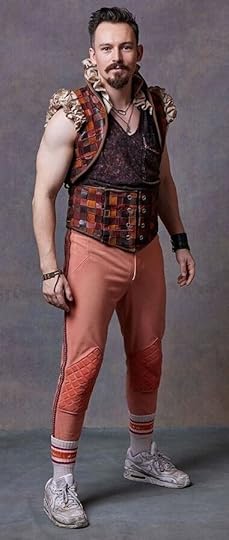
Henry
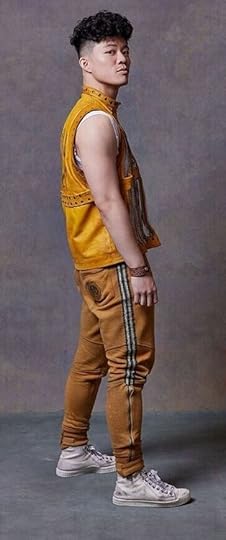
Kempe
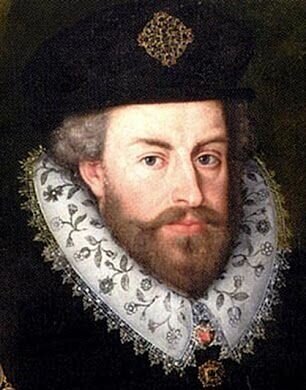
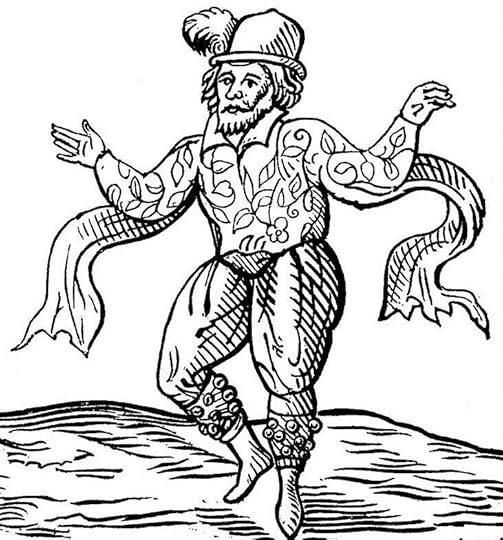
Henry (Alex Tranter) - This costume features super tight pants with slashing like details on them, an um, emphasized crotch that might be a reference to a codpiece, a leather-ish cropped vest and belt with cool cross-hatching details, and ruffling around the neck that looks like it’s meant to resemble a ruff.
Split Ruff- This looks a bit like the ruff in Robert Dudley’s portrait further up in the post, in the section on Shakespeare. The ruff began as an attached trimming to the high collar of a mid-16th century shirt or chemise (which looks to be the case here), but over time, developed into a separate accessory that could be worn with various different outfits. The discovery of starch in the 1560s really influenced the growth of ruffs, both in size and popularity. A large split ruff like the one in the portrait above became popular in the 1590s, when Elizabeth I was spotted wearing such looks. The ruff may also have been wired, to keep it standing up.
Slashing- Slashes are slits of different lengths cut into a garment in a specific pattern, for decorative purposes. The style became popular in northern Europe around the end of the 15th century.
Codpieces- As mentioned earlier, the codpiece was developed once doublet lengths went to above the waist, as the separate legs of men’s hose previously left a gap there that had to be covered. This started out as a very practical cloth covering but it become larger, more emphasized, and more decorated over time. Boning and padding was added and sometimes they were even large enough to hold money or jewels, which may have led to the saying “the family jewels.” You can see examples of them to the right and in the portrait of Henry VIII up earlier in the post. Their popularity may have also been influenced by the spread of syphilis; a codpiece allows for lots of room for bandages and ointments and such.
The name, funnily enough, comes from the middle English for both “scrotum” and “bag.” They were very popular under Henry VIII but eventually declined in popularity under his daughter Elizabeth I.
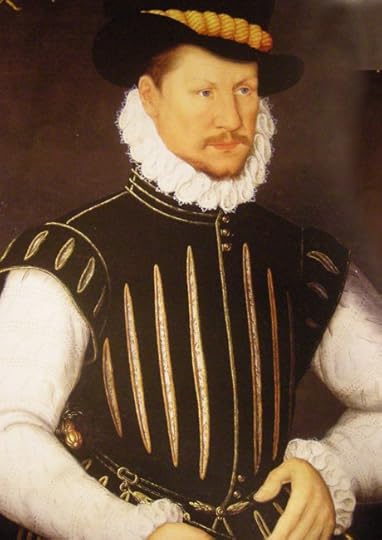
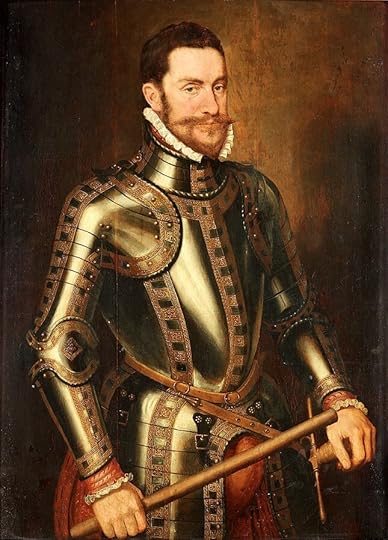
Renaissance gentleman in armour, unknown, circle of Peter Pourbus
Kempe (Kieran Lai) - I haven’t seen the play so I don’t know a lot of the details, but this character’s name, at least, is clearly based off of Will Kempe, an English comic actor who worked with Shakespeare. He was fairly famous at the time and in 1600, actually morris danced from London to Norwich (~100 miles); this took him nine days spread out over a few weeks. This drawing on the right shows him performing this stunt. The character Kempe’s costume doesn’t seem to owe much to this historical drawing except perhaps in the structure of the pants, which are tight at the bottom and baggier at the top, allowing for free movement during dancing.
His studded vest has some of the jack of plate elements I was talking about earlier and his pants look inspired by baggy hose.
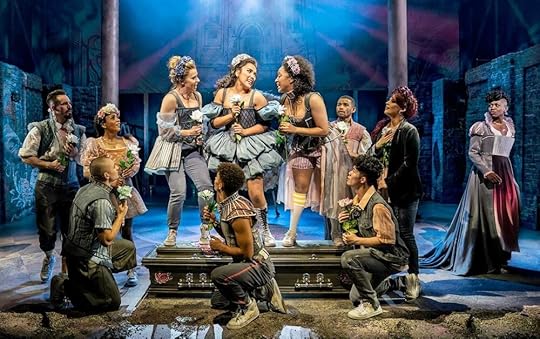
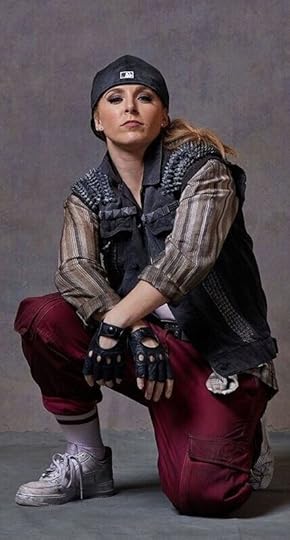
Benvolio
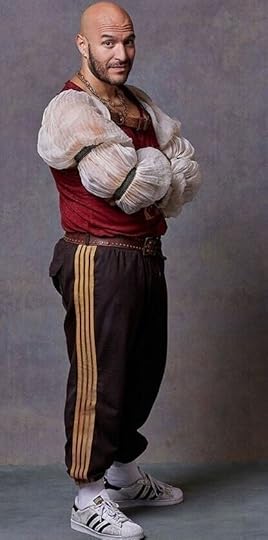
Sly
Benvolio (Kirstie Skiv) wears fingerless gloves, a hat, a spiky leather vest over a longer shirt, and sweat pants resembling hose.
Hat - Historically, almost everyone would be wearing a hat or hair covering of some sort. You just had your hair covered most of the time, that’s just…what you did. Benvolio’s one of the only characters who has a hat.
Gloves - Gloves were very popular among the rich in Tudor England, as they demonstrated that the wearers weren’t doing any manual work. They were shown in a lot of portraits and were often simply held by the sitters instead of being worn (you can see that in the portrait on the left below this text). Tudor England was really stinky, so gloves were often scented. In addition, this may be a stretch of a reference, but William Shakespeare’s father John Shakespeare WAS a glover, who made leather from animal hides and then into gloves.
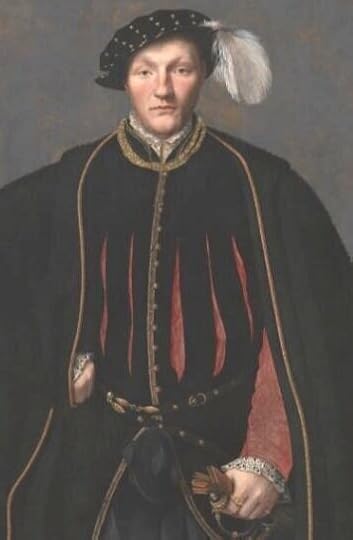
Portrait of a Gentleman, Unknown
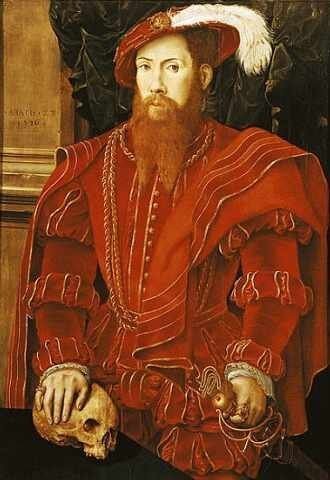
Portrait of a Gentleman of the English Court, by Hans Eworth
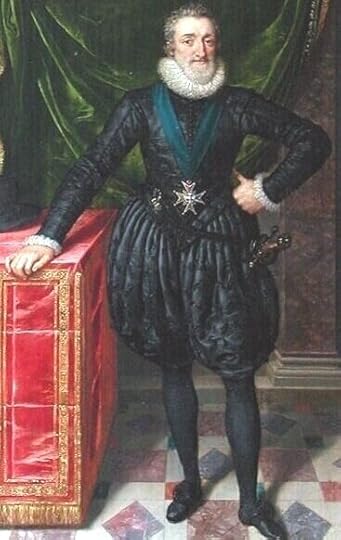
Henry IV, King of France, 1610, by France Pourbus the Younger
Sly (Ivan DeFreitas as Sly) wears super voluminous sleeves with ties in various places and super baggy pants that resemble baggy hose and/or trunkhose, with a belt.
Princess Jasmine sleeves - This costume features poufy sleeves with various ties on them. I don’t know how to describe these sleeves except they kind of look like Princess Jasmine’s hair. Since I don’t know how to describe them, I can’t really google them and figure out what they’re called, but I DID find this portrait above in the middle showing a Tudor era gentleman with very similarly shaped sleeves.
Poufy pants - Sly’s pants are so poufy that they almost look like the trunkhose that Juliet wears (see part 1 of this). As a reminder, those were voluminous breeches that usually ran from the waist to the middle of the thigh, and were worn with tight fitting hose under them.
March 11, 2020
Yes, Coronavirus is Scary. Go Eat a Bagel.
Last year, my husband was in the hospital for several days. It was a scary few days and it felt like there was very very little I could do to help him, so I just stayed with him, sleeping every night in a sleeping bag on the uncomfortable couch in his room, and did the few things I could do. I ran to go bug nurses when he needed more pain medicine, stole more blankets for him when he was still too cold, and threw blankets over various bright electrical lights and windows so he could sleep.
And every morning, while he was still asleep, I went downstairs to the hospital’s Panera and got a cinnamon crunch bagel with honey walnut cream cheese. Sure, I needed to eat, but that bagel also became something familiar and comforting that I could look forward to every day when things were uncertain.
I wasn’t really a huge Panera fan before this, and I still don’t go very often, but whenever I’m particularly stressed out, I go out and get that same bagel from the Panera down the road from my house. It’s my stress bagel. It reminds me of that time in the past when everything kinda sucked and was scary, but we managed to make it through anyway (my husband is fine now).
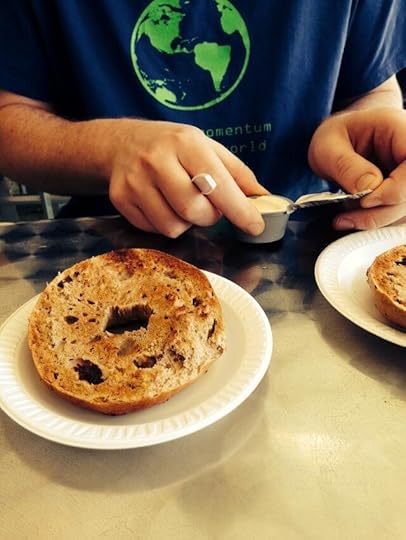
I’m currently at Panera, eating my stress bagel, with fashion history books strewn out in front of me ready for me to peruse. I intend to finish the second part of my historical inspirations of the &Juliet costumes today. But first, I wanted to just write a bit about what’s going on in our country and our world right now.
I live in Northern Virginia, near Washington D.C. The people around me are getting more and more scared every day about coronavirus and what it means for our lives. The local schools are preparing for switching to remote teaching set-ups; teachers I know have been asked to bring home two weeks worth of lesson planning materials when they leave for Spring Break. Friends of mine are just starting to work from home instead of coming into the office (lucky me, I telework full time already).
I know people who are scared to leave their houses. I also know people who are terrified of having to live in isolation for a year or more, knowing that such a situation would be disastrous for their mental health.
My husband asked me to go to the grocery store yesterday and stockpile on toilet paper; his boss told him there was a global shortage. I did so, reluctantly, but realizing it wasn’t the worst of ideas. I also bought some basic canned food and mac and cheese type non-perishable foods, in the event that we might have to self-quarantine in the future. I figure we’re going to use it all eventually anyway. The toilet paper at my local store was heavily depleted, but not out. However, the dry milk powder really was all gone. What is it about emergencies that makes everyone think of dry milk powder?
Everyone is scared. I’m certainly scared. But all the panicking is starting to make me panic too, and I can see the fear in my friends’ Facebook statuses as they post their fears about whether life will even be worth living here soon. Even those joking about cheap flights are scared. I seriously understand; humor is one of my go-to defense mechanisms.
There’s only so much we can do. We can be cautious ourselves, wash our hands for twenty seconds while reciting Shakespeare monologues, self-quarantine if we feel the slightest sniffle. But we are ultimately not in control of what happens, and looking at how other countries have dealt with this, I understand the panic. None of us want to see our cities or states or countries quarantined. Even if we understand that most otherwise healthy people survive COVID-19, we don’t want to die or see other people die. We worry about the immuno-compromised people in our lives, or the babies too young to have much of immunity to anything, or the elderly folks we love.
We’re all scared. And we have reason to be scared. I’m not by any means trying to downplay the danger here or forget about the people all over the world who have died from this. But panicking and whipping others up into a panic won’t help anything or anyone. We all need to be kind to each other and to ourselves right now.
Do what you need to to calm down. It’s okay to stop watching the news for a while if it only terrifies you more. Pray if you believe in a deity; meditate if you don’t. Get outside and exercise. Take up yoga. Talk to your friends about anything else. Pet your cats and dogs. Listen to music. Read a book. Write a blog post. Eat a bagel. Everything kinda sucks right now and it’s really scary, but humanity is going to make it through anyway.
March 2, 2020
Update: Six Alternates Won't Have Their Own Costumes on Broadway
Six Previews on Broadway: Costume Changes (continuously updated)
The Historical and Modern Inspirations in the Costumes of Six the Musical: Wives 1-3
The Historical and Modern Inspirations in the Costumes of Six the Musical: Wives 4-6
The Alternate Costumes of Six the Musical (Continuously updated!)
The Historical Inspirations and Costumes of the Ladies in Waiting of Six
The Tudor Fashion Elements of the Costumes in Six (with Painting References)
The Shoes of Six the Musical (Continuously updated!)
How the Six Alternates Change Their Styling for Each Queen
Quick and Short Six the Musical Costume Update (AUSTRALIA)
The Six fandom has been buzzing over the last week about the Broadway alternates’ costumes, as both Mallory Maedke and Nicole Kyoung-Mi Lambert took the stage in old versions of the regular costumes rather than the previous alternate costumes they wore in Chicago. There was speculation that the alternates were getting new costumes that just weren’t ready yet (as the show is technically still in previews; opening isn’t officially until March 12, 2020).
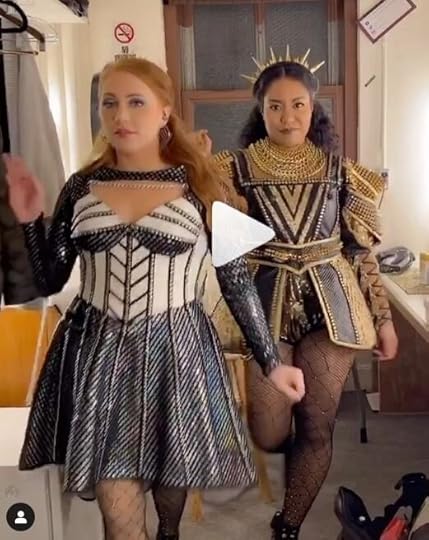
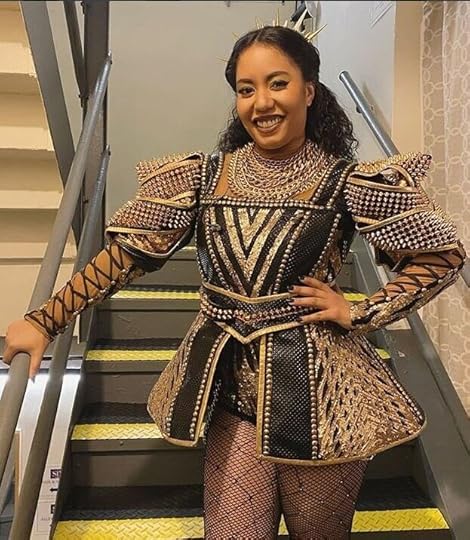
However, Lambert has now officially confirmed in the comments on Instagram that there won’t be any more alternate costumes on Broadway, for unspecified reasons. (MANY THANKS to Katie Proctor of the Six: The Musical (Fan Group) on Facebook for capturing and sharing this interaction).
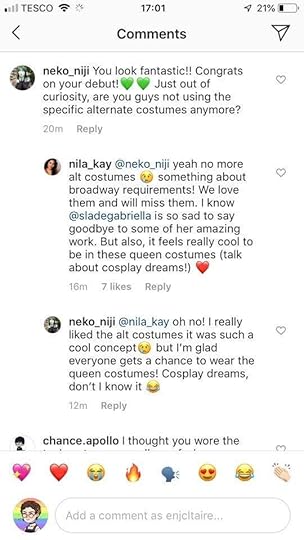
This is really sad to hear, the Queendom really loved the alternate costumes. It really seemed to be one of the big aspects setting the Six musical franchise apart from other shows; traditionally, alternates wear the same costumes as the main characters in the musical, but the special costumes really made them stand out in an exciting and unique way. I really don’t know anything about Broadway equity and/or union rules, but I’ll be looking into this a bit more this week to try to find the exact reason why this isn’t allowed. This seems to be just another thing on Broadway that’s different from the other shows (as I previously mentioned, filming and photography technically isn’t allowed during the Broadway Megasix, although it doesn’t look like the ushers or show have been enforcing that too hard).
It does seem like all the other shows will be continuing to use the special alternate costumes though, so those can still be seen in the 5 OTHER SHOWS running right now: in the West End in London, on the UK/Ireland Tour, on the Australia/New Zealand tour, and on two cruise ships: Norwegian Bliss and Norwegian Breakaway. Additional Performances will go up on the Norwegian Getaway in April and in Chicago and Wellington, Australia in July.
February 28, 2020
The Historical Influences of the Costumes of & Juliet: Part I
& Juliet is a 2019 musical now up in the West End in London that starts off at the end of Romeo & Juliet. Instead of killing herself, Juliet survives, and runs off to Paris with some friends to avoid being sent to a convent by her parents. Shenanigans ensue. There’s also a frame story about William Shakespeare and his wife, Anne Hathaway (no, not that one) arguing over how to plot out the story. All the songs in the musical are by Max Martin and were previously big pop hits; think “I Want it That Way,” “…One More Time",” “It’s Gonna Be Me, “Blow,” and other songs by Backstreet Boys, Britney Spears, NSync, and other artists.
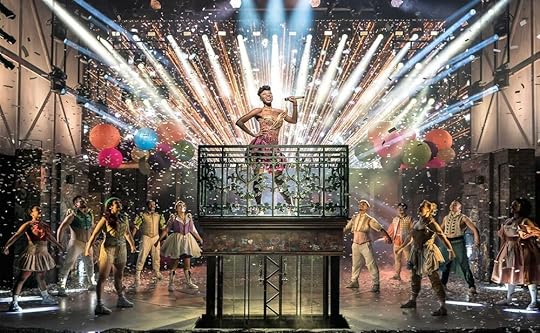
I’m not SUPER familiar with the musical, but I’ve listened to a bit of the soundtrack, have read through the WIkipedia page, and have seen some awesome photos of the costumes, which mash up renaissance and modern elements. So of course, I want to go through and analyze some of the costume elements through the lens of Tudor history. I’m not going to go AS in depth with these costumes as I previously have with Six, because & Juliet has WAY more than six characters and plenty of those characters seem to have several costumes. I’m also sure I won’t be able to get all the costumes, so I’m honestly not going to fuss about it too much.
Although Romeo and Juliet technically takes place in Italy, and most of this musical takes place in France, the costumes seem to be far more English renaissance inspired; there were a lot of similarities in renaissance dress in these three countries, but also some pretty striking differences.
Because there are so many characters and SO many costumes in this show, I’ve had to divide up this post into two to make it more manageable. :) Part two should come out next week, and will focus more on men’s costumes, although a few women and an awesome nonbinary character will also be covered.
(FYI: A fair amount of the explanation of the different elements is borrowed from my previous post on the Tudor fashion elements of the costumes in Six the Musical. )
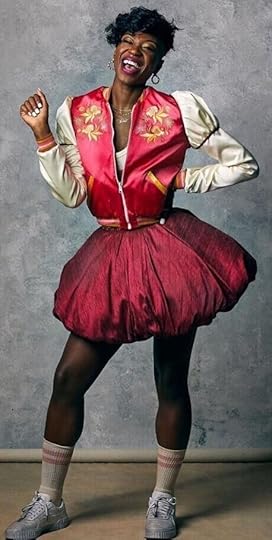
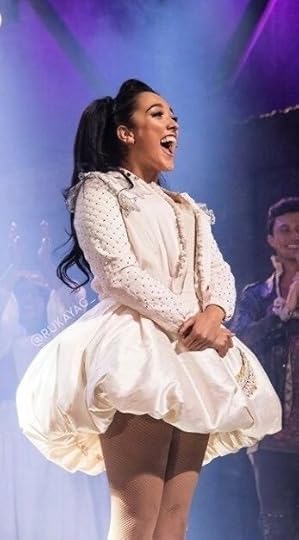
Understudy Grace Mouat on as Juliet
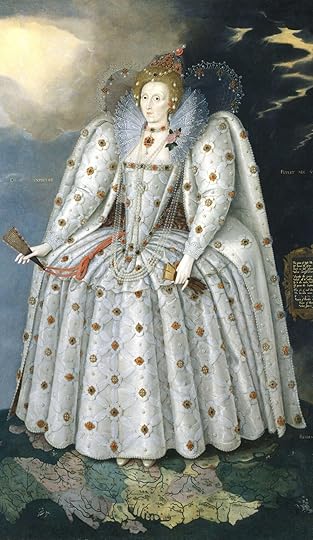
Elizabeth I wearing an intricately detailed dress and a great farthingale
Juliet (Miriam-Teak Lee)- As the main character, Juliet has numerous costumes, but at least in the few I’m seeing here, it seems like she usually wears tops that resemble corsets, with the stiffness and lines of boning and/or stays evident, but without lacing. She also sports a lot of wide square necklines, long sleeves, and a fair amount of bling, in the form of necklaces and bracelets. Of interest: the white jacket she wears at the end of the show has little cross hatching and beading details on it that actually somewhat resemble Elizabeth I’s sleeves in the portrait I’ve included above.
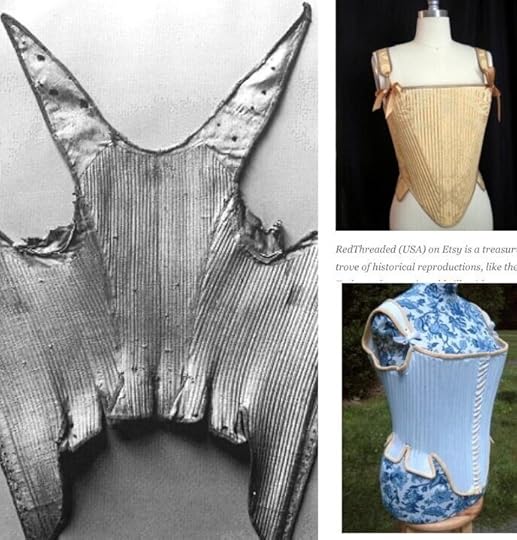
Elizabeth I’s effigy corset and examples of boning in modern recreations
Several of her skirts are very poufy, resembling both the volume of Tudor skirts. Her blue outfit also features big poufy pants, which are similar to some men’s styles of the time. It looks like she’s wearing similar pants in the photograph at the top of this post, only in pink, but I couldn’t find any close up pictures of this costume to confirm it.
It looks like almost all the shoes used in the musical are very deliberately worn and a little ragged around the edges, with a few specific exceptions. I wonder what the meaning of that is.
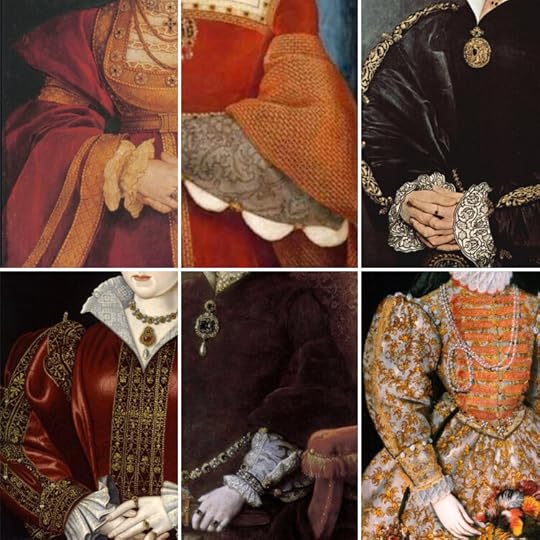
Details of paintings from (starting top left, going clockwise): Anne of Cleves, Jane Seymour, Catherine Howard, Elizabeth I, Mary I, and Catherine Parr.
Boning/Stays - The supportive looking lines in Juliet’s white dress top look to refer to boning within dresses and supportive stays.These aren’t overtly Tudor, as they’re generally associated with later time periods, and I unfortunately don’t have any painting references for this because they were explicitly /underwear/ and not something that would show up in art, but we do know that whalebone was used for support in women’s garments at least by the time of Elizabeth I’s death, as her effigy wore a corset containing whalebone. I’ve included a picture of the effigy corset and a few pictures of historical reproduction corsets so you can see what I mean.
Wide square necklines - Wide and low cut square necklines were very big in women’s fashion under Henry VIII, from about 1500-1550.
Bling- In Tudor times, noble ladies would often wear lots of rings, bracelets, and several necklaces. You can see this in their portraits.
Sleeves - All Tudor women would have worn long sleeves coming down at least to the wrist, and sometimes below that. These often were very voluminous at the top.
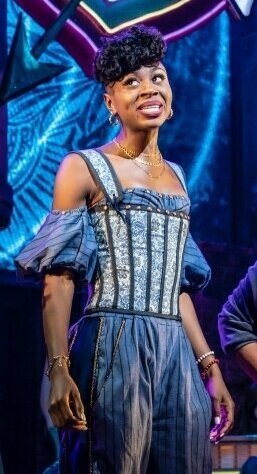
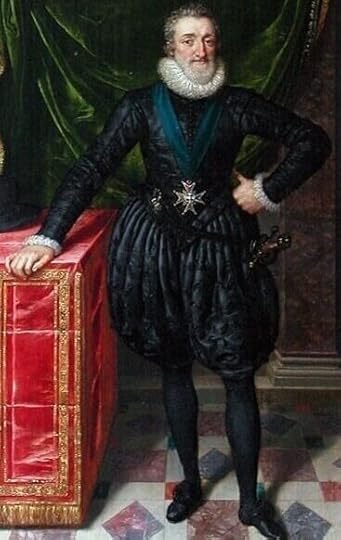
Henry IV, King of France, by Frans Pourbus the Younger
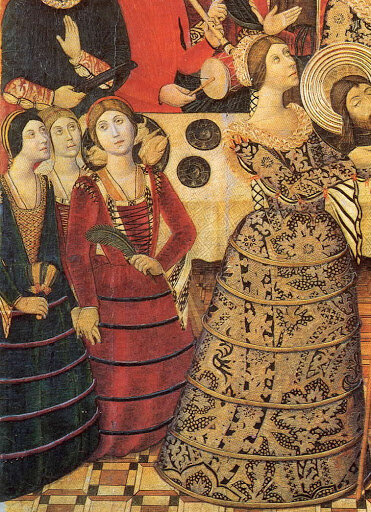
Spanish farthingales
Poufy Skirts - The voluminous skirts Juliet wears in her pink and white outfits seem inspired by Tudor skirts, which were of a decent size. Tudor skirts weren’t even close to the biggest skirts in history (that honor belongs to the French court dresses of the 1760s-70s-ish, which often featured panniers, structured undergarments which stretched the skirts out horizontally by several feet) but they were still rather large at times! That’s generally due to the farthingale, but bum rolls contributed a bit as well (I’ll talk about bum rolls later in this post).
Catherine of Aragon brought the Spanish farthingale (hoop skirt) fashion into England when she married Prince Arthur (Henry VIII’s older brother, who died less than a year into their marriage). These early farthingales were usually made with wood; the name actually derives from the Spanish word verdugo, which means “green wood.” French farthingales, which started showing up in England in the 1520s, possibly due to Anne Boleyn’s influence on fashion, were often stuffed with cotton and stiffened with hoops of wood, reed, or whalebone. Although we know the materials that made up these undergarments, as tailor’s receipts and such have survived, we don’t know exactly what they look like, because, as an undergarment, they weren’t visible in paintings (boudoir art that showed women in their underwear wouldn’t be culturally acceptable in England for a LONG time).
Later, by the time of Elizabeth I, these French farthingales became “great farthingales,” which ballooned the skirts out all around. You can see that in the portrait of Queen Elizabeth in the previous section. The classic Tudor silhouette you see in portraits, showing an inverted triangle waist dropping down into a voluminous skirt, is created by farthingales.
Poufy pants - These are actually called trunkhose. They were voluminous breeches that usually ran from the waist to the middle of the thigh, and were worn with tight fitting hose under them. They were worn by men in the 16th and 17th centuries. They kind of look like onions, right?
I’m trying to pin down more information about when exactly men started wearing trunkhose and why (if there is ever a reason for fashion), but unfortunately, I’ve found it’s much more difficult to find information on men’s renaissance fashion than women’s (see: reasons I’m putting off the second post of this series until next week).
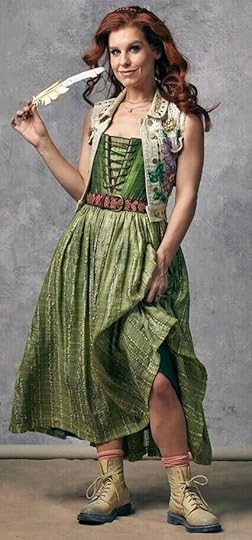
Anne Hathaway
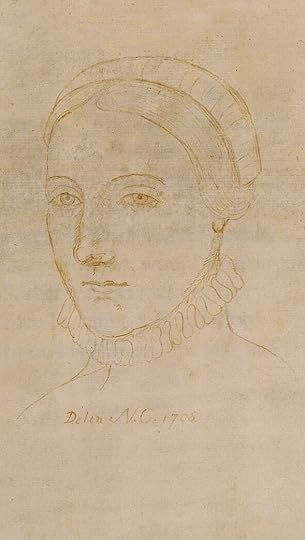
A 1708 drawing that purportedly shows Anne Hathaway, William Shakespeare’s wife.
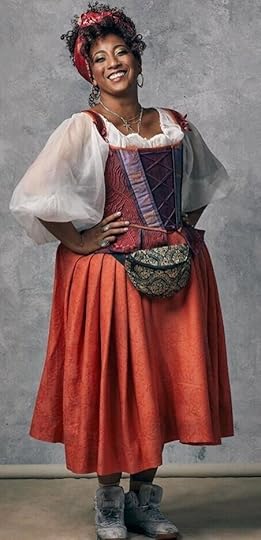
Angelique
Anne Hathaway (Cassidy Janson) - This outfit features cross-lacing, a corset style top that appears to have the stiffness and structure of boning/stays, a wide, square neckline, and a belt at the waist, all elements commonly seen in noble lady fashions during Henry’s reign.
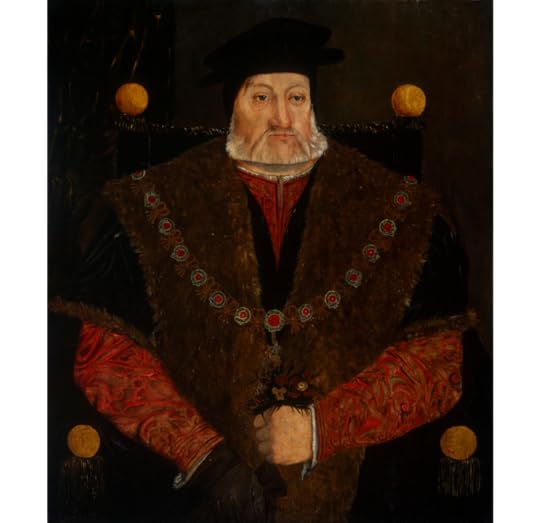
Charles Brandon, Duke of Suffolk
The vest is interesting. In terms of Tudor fashion, it most resembles an overcoat, which was normally worn by men (see the portrait of Charles Brandon to the right), and is covered with gorgeous colorful embroidery. I’m guessing this refers to her role in the play, in which she takes some of the story-telling power away from her husband.
I’ve included a purported portrait of the historical Anne Hathaway for reference, but it’s basically just her face and a ruff. I don’t think there’s much inspiration to be found here.
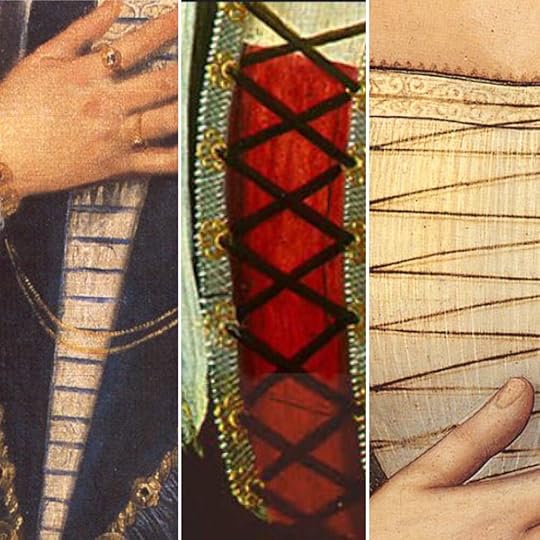
Cross lacing detail from a portrait
Cross-Lacing - The “corset” top here is cross-laced, looking like a shoelace tie. This is pretty much what you see at every renaissance faire. In reality though, Tudor gowns were generally spiral laced or ladder laced rather than cross laced (Xes) You can see what I mean in the collection of painting references; all of these show spiral lacing or ladder lacing except for one Italian painting, which shows Xes which are almost certainly more decorative than practical. The other forms of lacing are simply more supportive and adjustable, which is the entire idea behind having lacings in an outfit anyway, after all.
Embroidery - Since almost every young girl was taught to work with a needle, and pretty much every noble lady could embroider, embroidery was very commonly seen in the clothing of nobles. You can see many different examples in the portraits I’ve shared throughout this post.
There were sumptuary laws that restricted what color and type of clothing and trims could be worn by people of various ranks; embroidery was pretty much only allowed for nobles or knights, so it’s questionable whether the historical Anne Hathaway would have been allowed to wear embroidery, as Shakespeare was neither a nobleman nor a knight. However, sumptuary laws were relaxed onstage, and actors could wear clothing that they’d be banned from wearing otherwise, as long as they were performing in a play at the time.
Angelique, Juliet’s nurse (Melanie La Barrie) - This honestly looks like the most renaissance costume in the show, complete with a fanny pack resembling a belt and purse and a hair covering. This is a very standard outfit for a female peasant, featuring a woolen undershirt, and a matching skirt and corset style top (with more of that cross lacing). In actuality, the entire orange layer would probably be a single dress, known as a kirtle, which commonly featured square-necks and came down to the ankles.
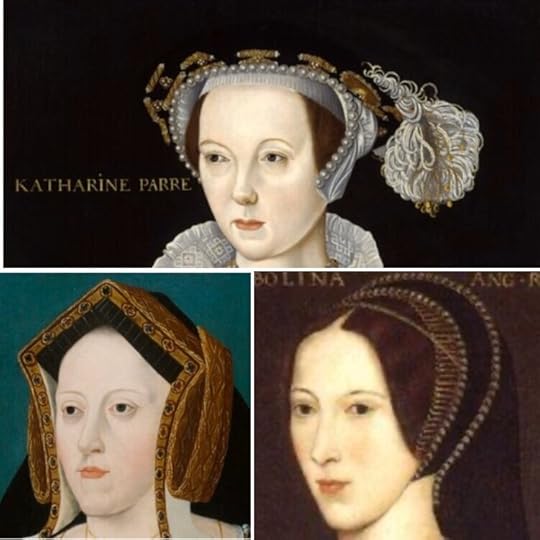
Details from portraits, showing the gable hood of Catherine of Aragon, the French hood of Anne Boleyn, and Catherine Parr’s feathered hat.
Belt and Purse - The fanny pack is a wonderful little touch, as people generally did wear purses on their belts.
Hair Covering - Angelique also is sporting a hair covering here; historically, almost everyone would be wearing a hat or hair covering of some sort (ignore the hair in The Tudors and The White Queen y'all, it's just...hilariously wrong). Famous hats included the Gable hood (seen on Catherine of Aragon and Jane Seymour) and the French hood (popularized by Anne Boleyn and seen in her portrait and in Katherine Howard's supposed portrait). Women even started wearing male hat styles at times, as seen in Catherine Parr’s portrait.
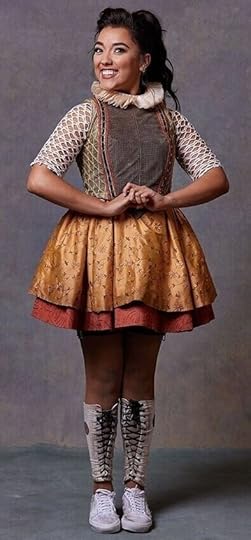
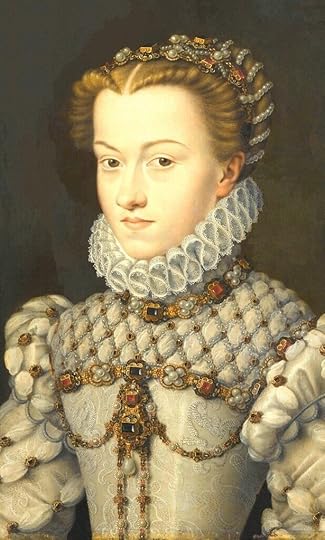
Elisabeth of Austria by Francois Clouet, ca. 1571
Judith (Grace Mouat)- This costume features numerous Tudor costume elements, including a ruff, white cross hatched sleeves, a double layered skirt rendered in rich orange and reddish orange colors and decorated with copious embroidery, and cross lacing in her leg warmers. I found the Elisabeth of Austria portrait above to demonstrate the sleeves but wow, this costume might actually be totally inspired by it? The color scheme and collar set up is very similar. The anonymous portrait below demonstrates a mesh look more clearly though.
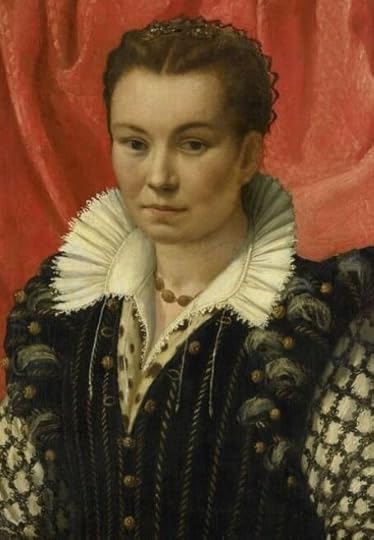
Portrait of a Woman, anonymous, 1525-1549
Ruffs - Neck ruffs like this ARE Tudor and specifically, Elizabethan (as opposed to the previously discussed square necklines, which were very Henrican). You didn’t really see them until the 1560s. Keep in mind: Henry VIII died in 1547, his son Edward VI ruled from 1547-1553, his daughter Mary I ruled from 1553-1558, and his younger daughter Elizabeth I ruled from 1558-1603; William Shakespeare lived from 1564-1616 and was active as a playwright probably from the mid-1580s to 1613.
Ruffs were made of fabric, usually cambric but sometimes lace (particularly if you were rich) and were later stiffened with starch imported from continental Europe (think around the Netherlands). They were separate pieces so you could wear a ruff with multiple different outfits, and specifically over the high necklines common to Elizabeth I’s reign. They started out pretty small, but once starch was discovered, ruffs became larger and larger, sometimes up to a foot wide. Really big ruffs had a wire frame to support them.
Fun fact: Apparently ruffs are still part of the ceremonial garments for the Church of Denmark!
Double layer skirt - There were lots of layers to women’s garments at this time and often, an over dress, shirt, and skirt were all visible.
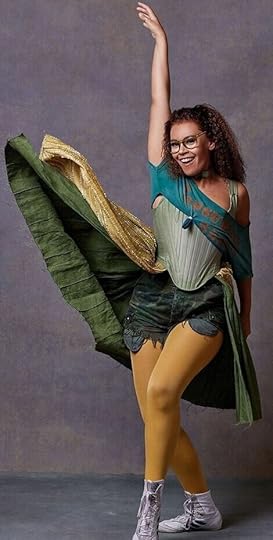
Nell
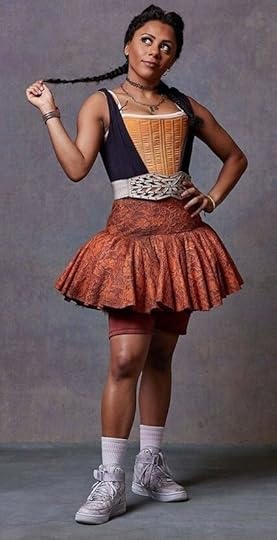
Susanna
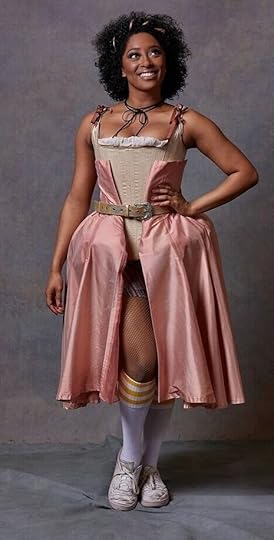
Lucy
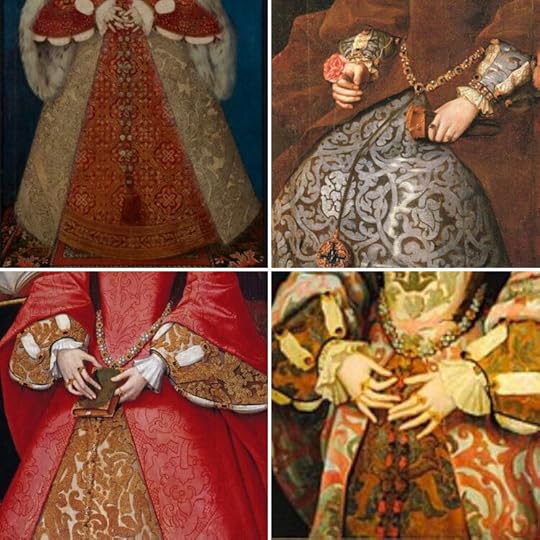
From left, going clockwise: details of paintings of Catherine Parr , Mary I, another of Catherine Parr, and Princess Elizabeth.
Nell (Jocasta Almgill) - This outfit is so fun. Tudor elements include her hair covering (which vaguely resembles a French hood in shape), the boning/stays, the splitskirt layered over denim shorts, and stockings. I can’t quite tell, but it looks like the t-shirt over the outfit has some sort of writing on it? Does anyone know what this is?
Split skirts - Nell’s and Lucy’s costumes both evoke the look of a classic Tudor dress under Henry VIII, in which a kirtle (underdress) was layered under a contrasting overdress. You can see this demonstrated at right, which includes details from portraits of Mary I, Princess Elizabeth.
Susanna (Kerrin Orville) - Here you’ve got boning/stays, a top that vaguely looks like an overdress, a belt, layers of a skirt over shorts, and a choker necklace.
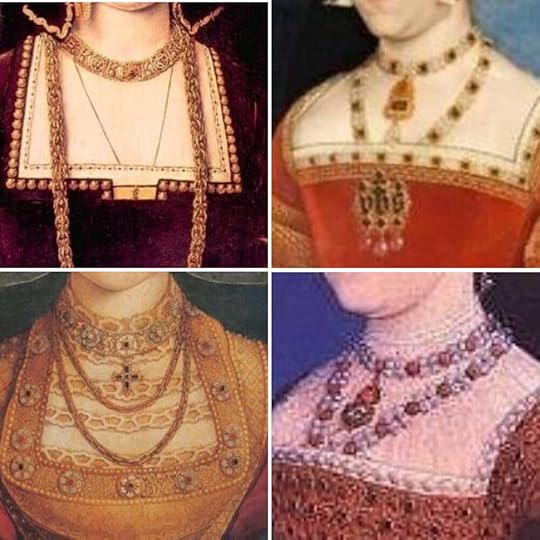
From left, going clockwise: details of paintings of a young Catherine of Aragon, Jane Seymour, Catherine Howard, and Anne of Cleves.
Chokers - Chokers were super popular in renaissance times! You can see several examples in portraits I’ve shared throughout this post. Even the famous “B” necklace from Anne Boleyn’s portrait is a choker.
Lucy (Danielle Fiamanya) - This costume includes split skirts worn with a bum roll, boning/stay type elements in the top, and a tied ribbon choker necklace.
Bum Roll - Roll farthingales, or “bum rolls” were padded rolls covered in cotton fabric. They sometimes included wiring. The roll would be placed around the hips and under the kirtle. The one shown in Lucy’s costume appears to be a demi-roll, since it is clearly defined under the skirt but doesn’t completely encircle the body.
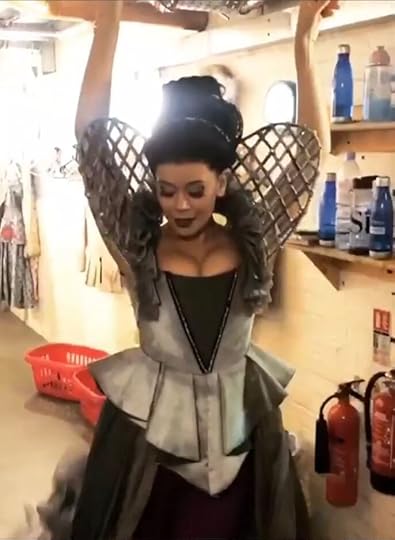
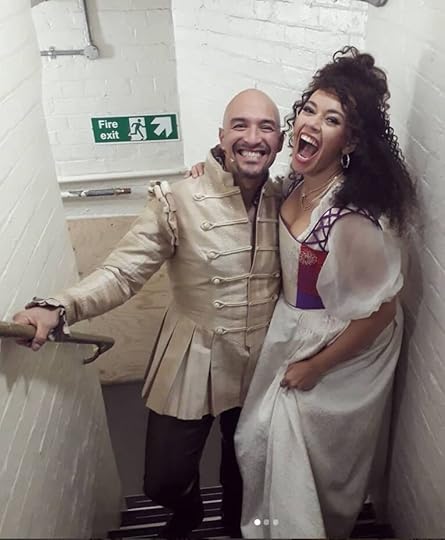
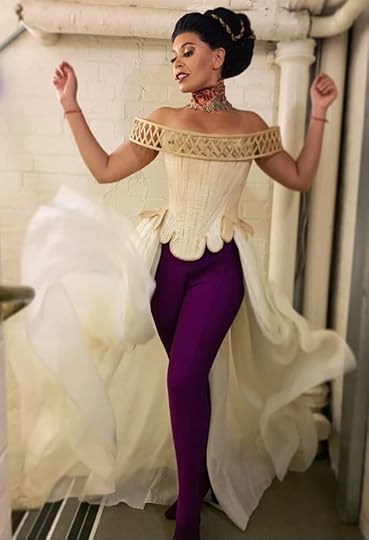
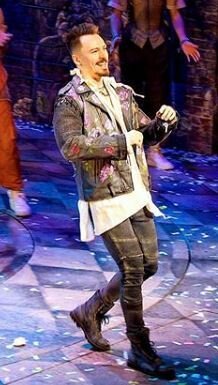

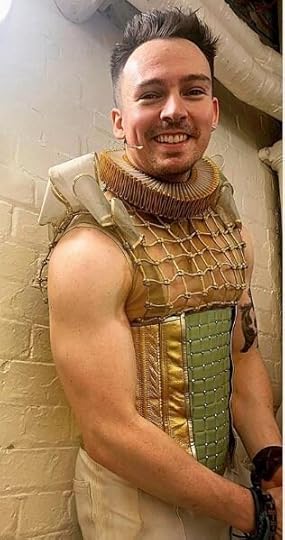
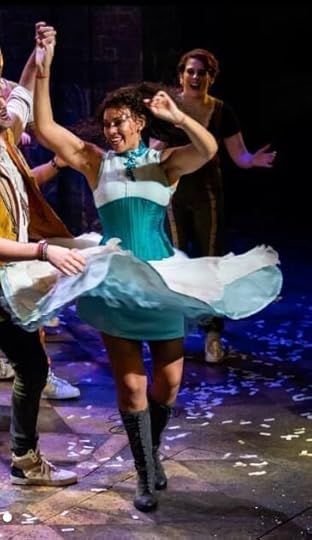
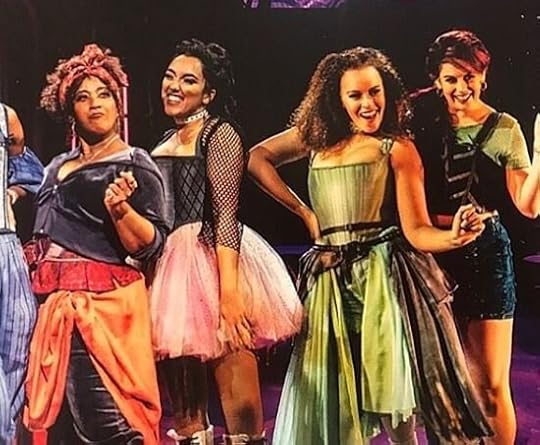

I don’t have the time to analyze every single costume in the show, and since I haven’t seen the show and don’t have plans to go to London any time soon, I don’t have any way to check if I found all the costumes or not. But I’ve put together a gallery from various photos I can find on Instagram of other costumes anyway; look at how gorgeous they are!



